 |
|
Having spent 20 years using an "exception" in the Endangered Species Act (just for plants), and with the official recovery plan and actions still refusing to experiment with poleward "assisted migration" of this "glacial relict", Connie was inspired to produce another video — the day after Fred Bess (Cleveland, Ohio) delivered a portion of his new seed harvest to her in Ypsilanti, Michigan.
VIDEO EPISODE #38 is an hour long on youtube:
"DOGE for Endangered Plants - Cut costs, get results, follow our lead (Torreya Guardians)"
|
Open the VIDEO caption and see the time-coded table of topics. Key POLICY suggestions for the new federal administration:
25:13 CORE SECTION OF THE VIDEO: Elements of the POLICY SHIFT Connie proposes, and how a 2023 regulatory change that eliminated "HISTORICAL RANGE" as a constraint for locating "experimental populations" opens the way.
32:15 SUMMARY OF THE 2-PART POLICY SHIFT proposal: (1) Require SEED DOCUMENTATION annually by institutions in charge of the ex situ orchards of wild genetics and (2) OFFER EXCESS SEEDS (and no money) to others for experimental populations. Importance of recording "negative results." The group has proven that any planting at or south of CLEVELAND OHIO is likely to succeed.
35:40 Another POLICY FOR IMPLEMENTATION: Create a category to expedite experimental populations for PLANTS designated as "SPECIAL NEEDS SPECIES." Three thresholds: (1) Listed for 2 or more decades; (2) Recovery actions haven't worked; (3) Declining in historical range. The SE region of FWS is best place to start evaluating.
• November 2024/ Bill Brodovich / New Torreya Guardian in southern Michigan (Ann Arbor)
Autumn of 2024, Connie Barlow gave 21 seeds from the pot of 238 seeds she was keeping for a second winter of stratification of seeds from Fred Bess's 2023 harvest of seeds in Cleveland, Ohio. She gave these to a conifer specialist, Bill Brodovich, in Ann Arbor, MICHIGAN
 |
|
I planted the Torreya seeds on November 4. I planted one seed in each of 21 one-gallon containers, and then buried the containers in the ground in my yard. Each container has a numbered tag.
As an experiment, I added 1 cup of lime (calcium carbonate) to 2 containers, half a cup to two containers, and a quarter cup to 2 containers. Since the species is native to limestone bluffs, so I thought it would be interesting to see if the additional calcium affects their growth.
I buried two of the seeds 2 inches deep, and all the rest 4 inches deep. I then covered the containers with fencing to keep the squirrels out.
Now I have to wait out the winter — that is, if we get a winter. I can't believe how mild this fall has been. Some trees in my neighborhood are still hanging on to their brilliant leaves.
|
• November 2024/ Joe Facendola / New seed cleaning method for the ~1,250 seeds collected in North Carolina
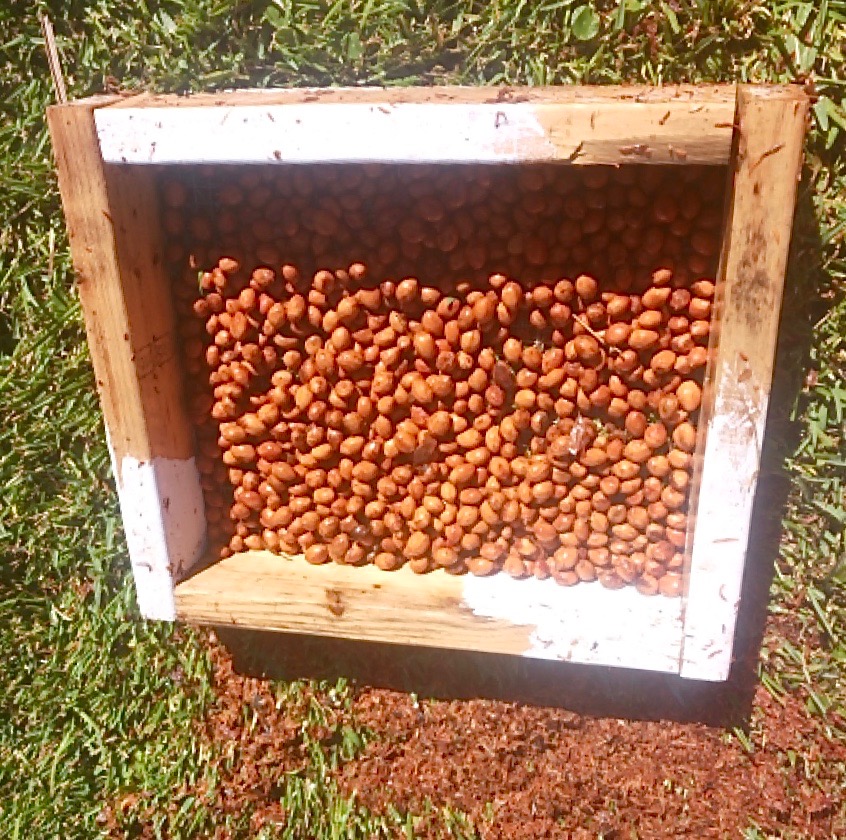 |
|
Since 2019, Joe Facendola (of Wilmington NC) has been collecting seeds at two homes in North Carolina: Clinton and Mt. Olive. He then prepares them for shipping and planting by volunteers.
LEFT: Approx. 600 cleaned seeds collected from the pair of torreya trees in Mt. Olive. They are sitting in a half-inch mesh screen tray. Remnants of the sarcotesta that were squished off, then rinsed with the hose, are below the screen frame.
METHOD: I first soak the collected whole seeds for 2 or 3 days, changing the water daily. Next I dump them out onto a .5" wire screen. I use a gloved hand to squish them around to remove the softened sarcotesta, and blast them with a jet of water from the hose while shaking the screen. They get dumped back into the bucket and rinsed with a jet of water from the hose again before getting one final rinse on the screen.
|
• November 2024/ Joe Facendola and Connie Barlow/ New growth-form experiment launched in coastal North Carolina
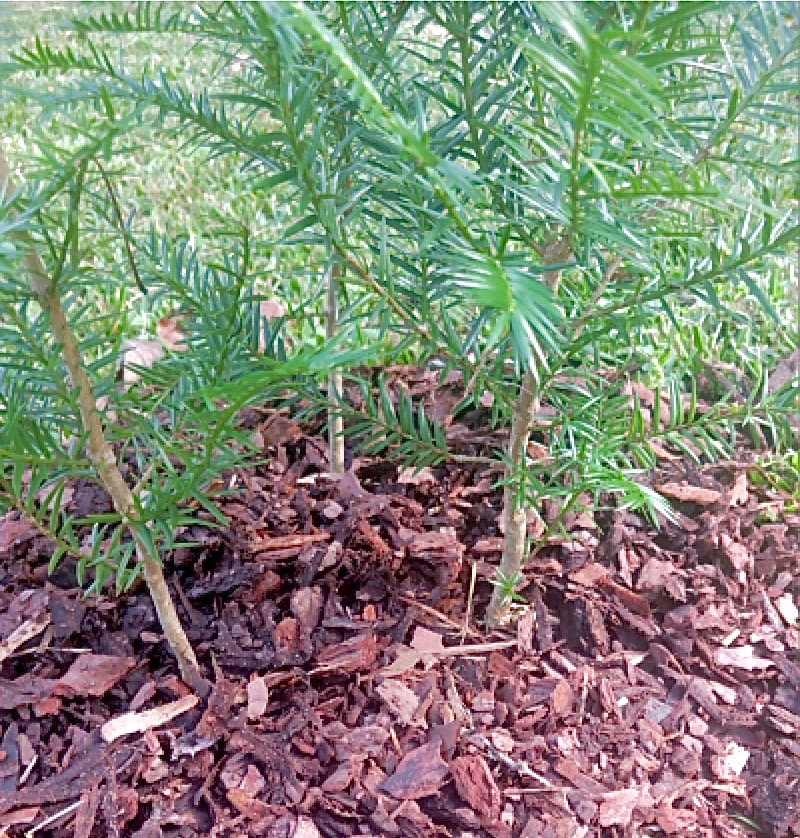 |
|
JOE FACENDOLA began planting torreya seedlings in his backyard in Castle Hayne (a suburb of Wilmington) in 2023.
His plants receive a lot of sunlight in his backyard, and they have no competition because they are planted on mowed lawn.
Joe is the first Torreya Guardian to experiment with planting clumps of seedlings in sets of 3, each about 6 inches from the others (photo). Will this planting prove feasible for all three to grow together into a tree form? Will such clumping reduce herbivore damage to the leaders and inner branches? And once they become old enough to attract buck deer antler rubbing, will this form also reduce such damage?
In November 2024, Joe planted an additional two clumps like this (photo left) in his mowed backyard, each about 10 feet away from the others. There are a total of 9 plants now, in 3 clumps.
|
• November 2024/ Mike Heim/ Status of 16 young torreyas in northern WISCONSIN
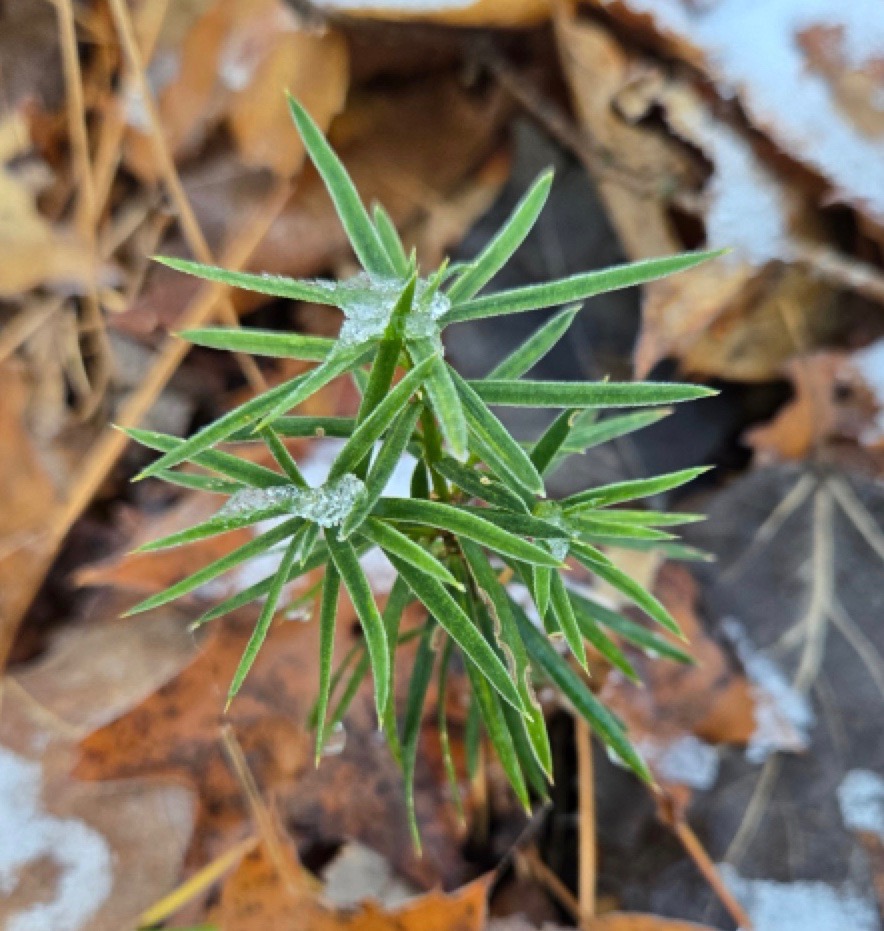 |
|
I just finished mapping the 16 T. taxifolia in the woodland exclosure.
One is a rooted-cutting planted last year. The 15 young seedlings emerged from seeds harvested in Clinton and Mt. Olive NC in November 2020. Those seeds were direct planted in Wisconsin that same month, beneath a deciduous canopy and within a fenced deer exclosure.
Just 3 of total had shown up as seedlings during 2023. The other 12 showed above-ground growth for the first time this year.
These findings thus document that, in northern Wisconsin, wild-planted seeds take more than the usual 2 summers to appear as seedlings. Some required 3 summers; most required 4.
LEFT: Freezing nights have arrived in Wisconsin.
• Mike's torreya page.
|
• November 2024/ Fred Bess/ Parma, OHIO, photos of seed harvest from 3 female stems
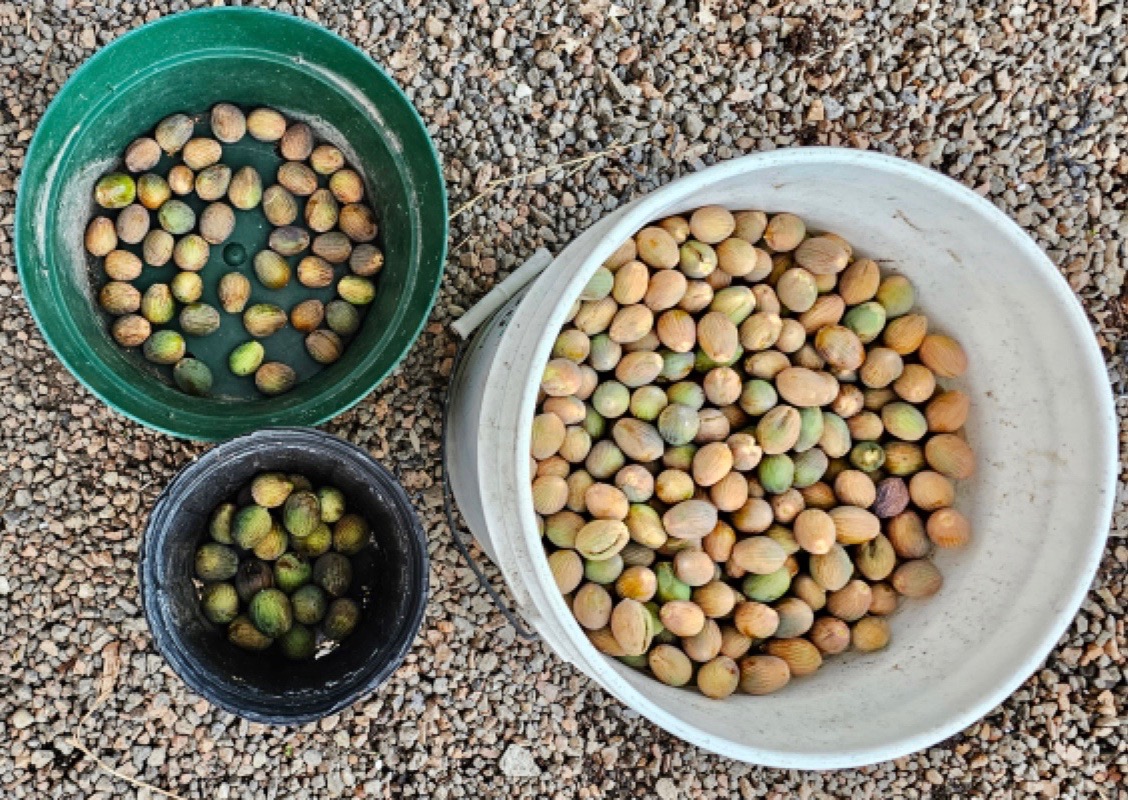 |
|
Fred reports, "I harvested this year's seeds on November 2, after noticing that they were beginning to fall."
Seed production was reduced from the amount in 2023, but still quite high.
ESTIMATED COUNT: "Around 40 from the twin tree female, 30 from the cutting-grown female, and my big girl likely has around 800."
• Fred's torreya page.
|
• November 2024 / Connie Barlow / HISTORIC GROVES map and page updated for SITES OF NEW SEED PRODUCTION by Torreya Guardians
Exactly 20 years after the late Paul S. Martin and I published in Wild Earth magazine our advocacy paper, "Bring Torreya taxifolia North — Now", two more sites of Torreya Guardians northward plantings have been documented as producing seeds.
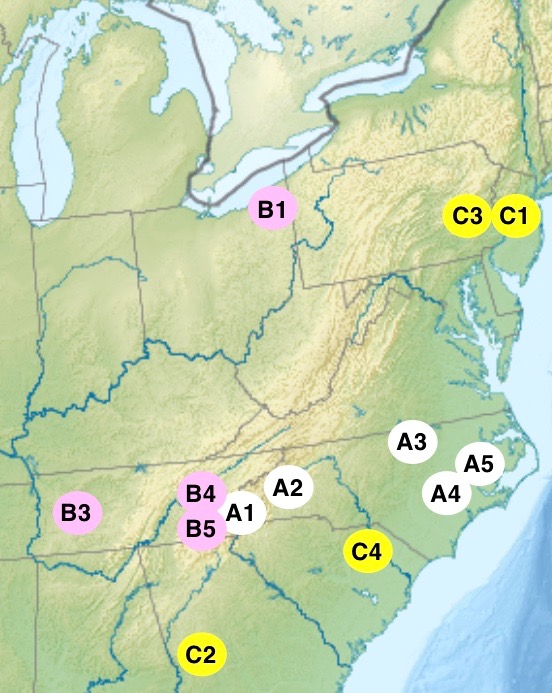 |
|
The TWO NEW SITES are shown on this segment of map as B4 and B5 — with PINK signifying "Mature Trees Producing Seeds". (WHITE are sites fully "naturalized" because they are old enough to have offspring establishing in their surrounds. YELLOW are old and thus mature trees, but with no documented seed production.)
That new plantings in North Carolina by Torreya Guardians are now producing seeds is not surprising. Notice the 5 WHITE sites in North Carolina that were planted and producing seeds before our group got started.
The B1 pink site at CLEVELAND OHIO (planted by Torreya Guardian Fred Bess) is still our banner site. Seed production there began in 2018. Even that far north is proven suitable for assisted migration of our country's most famous "left behind" glacial relict: Florida Torreya.
Visit our Historic Groves page, and see the new seed photos taken by Torreya Guardian Joseph Guite at B4 (Cowee Valley, NC) and at B5 (Tessentee Bottomlands Preserve).
|
• October 2024 / Joseph Guite / Visited 3 TORREYA GUARDIANS PLANTINGS in western NC and documented SEED PRODUCTION at two of them.
|
| 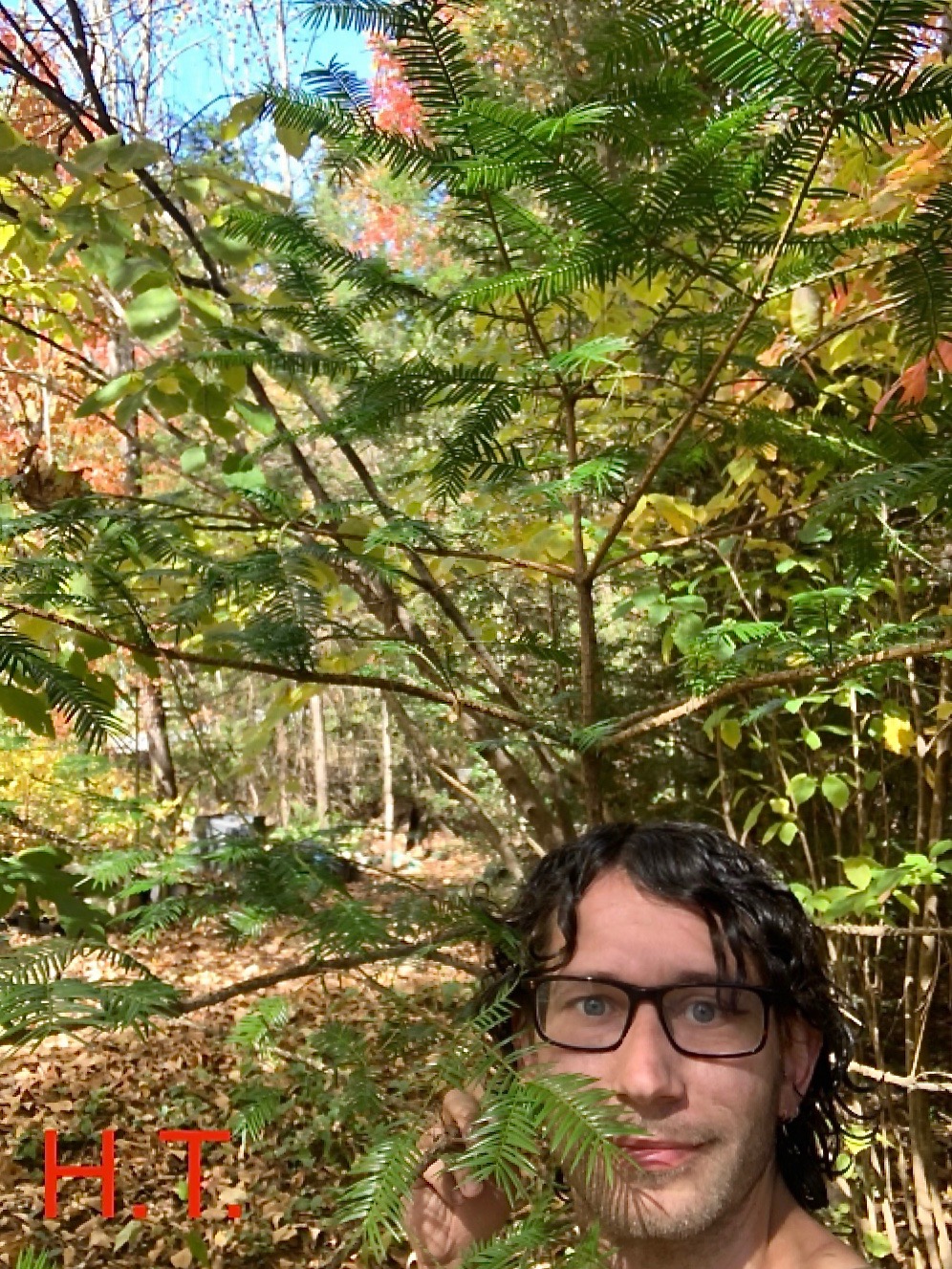 |
|
JOSEPH GUITE is one or our newest Torreya Guardians.
He happened to be visiting in North Carolina when Hurricane Helene hit. While using his own truck for transporting relief supplies to the flood victims, he took a quick side visit to our 2008 plantings at LAKE JUNALUSKA. Four torreyas are still alive there, with the tallest being the Thoreau tree (photo at left). See more of his Lake Junaluska torreya photos.
On his way to wintering in Florida he visited two more plantings in North Carolina by Torreya Guardians.
PHOTO BELOW LEFT: Our Cowee Valley planter, Lamar Marshall, had already reported first seeds in 2023. Joseph photo-documented the 5 full-sun trees there, with seeds on 3 of them.
PHOTO BELOW: Joseph made the first documentation of seed production on some of the 30 torreyas planted in 2012 at the Tessentee Preserve.
See all his photos of torreyas at Cowee Valley and
Tessentee Preserve.
|
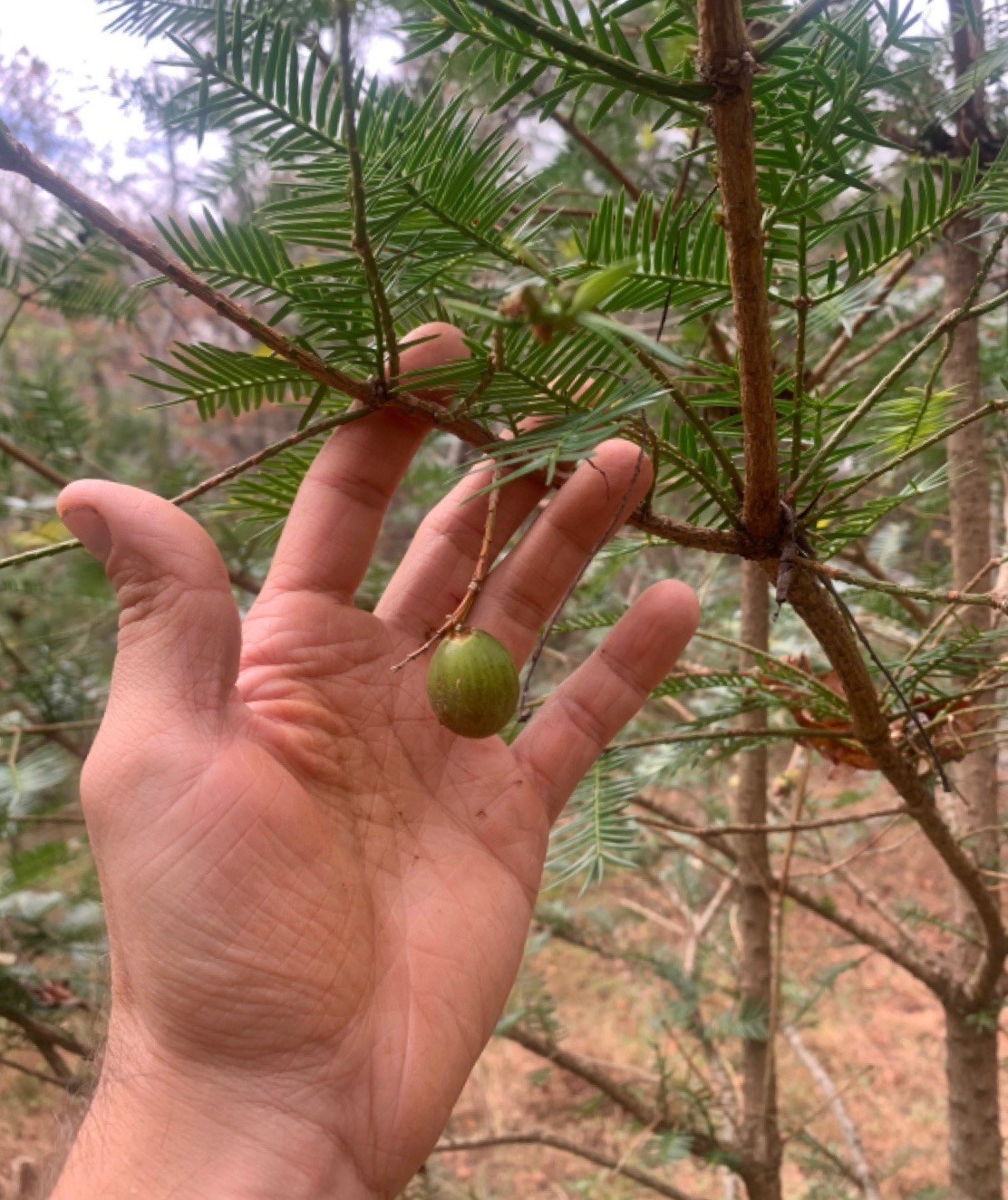
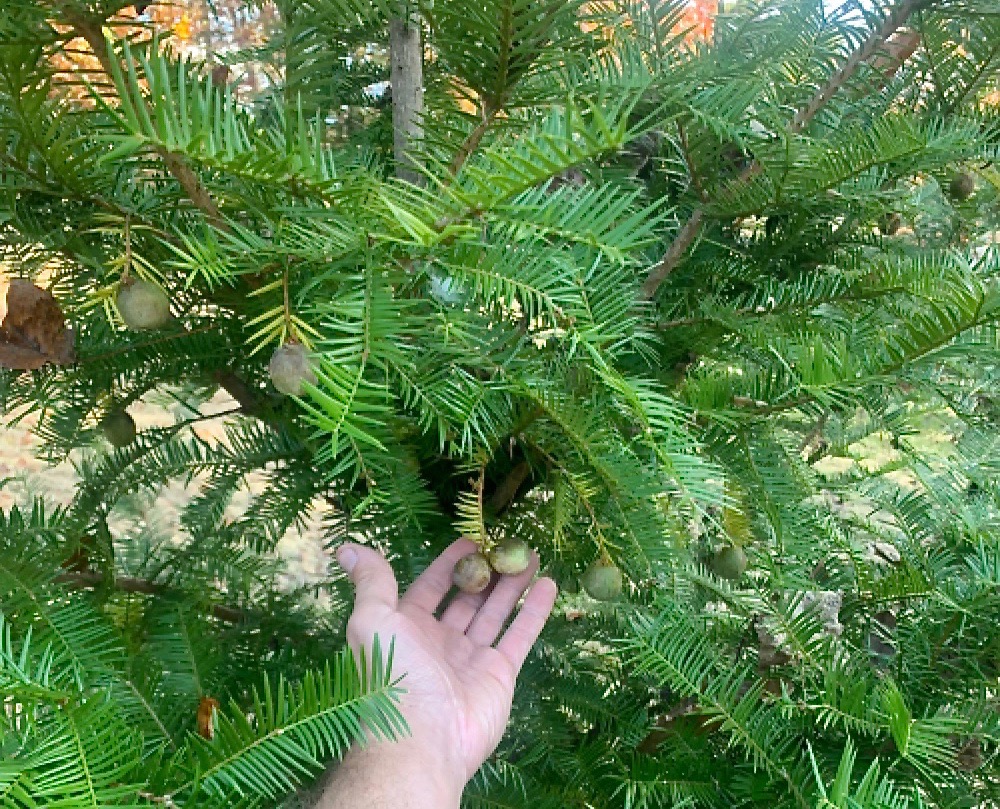
• October 2024 / Russell Regnery / Documentation of Florida Torreya at Highlands Biological Station NC
 |
| |
Highlands Biological Station, in Highlands NC, is associated with Western Carolina University.
Specimens of Florida torreya had apparently already been planted onsite before Torreya Guardians in 2015 served as a conduit for donated seeds (of wild genetics) from one of the two official ex situ orchards of the species in northeastern Georgia.
Russell Regnery (Torreya planter near Franklin NC) had partnered with Jack Johnston (Torreya planter in NE Georgia) in 2022 as volunteers to safely transplant existing scattered specimens at the station into one area, where cross pollination could eventually occur.
Russ returned in 2024 to check on the health of transplanted specimens and to photograph the tallest among them (LEFT). There is no documentation yet of seed production.
|
• September 2024 / Don Thomas / Photos of California torreya seedlings in shade v. full light
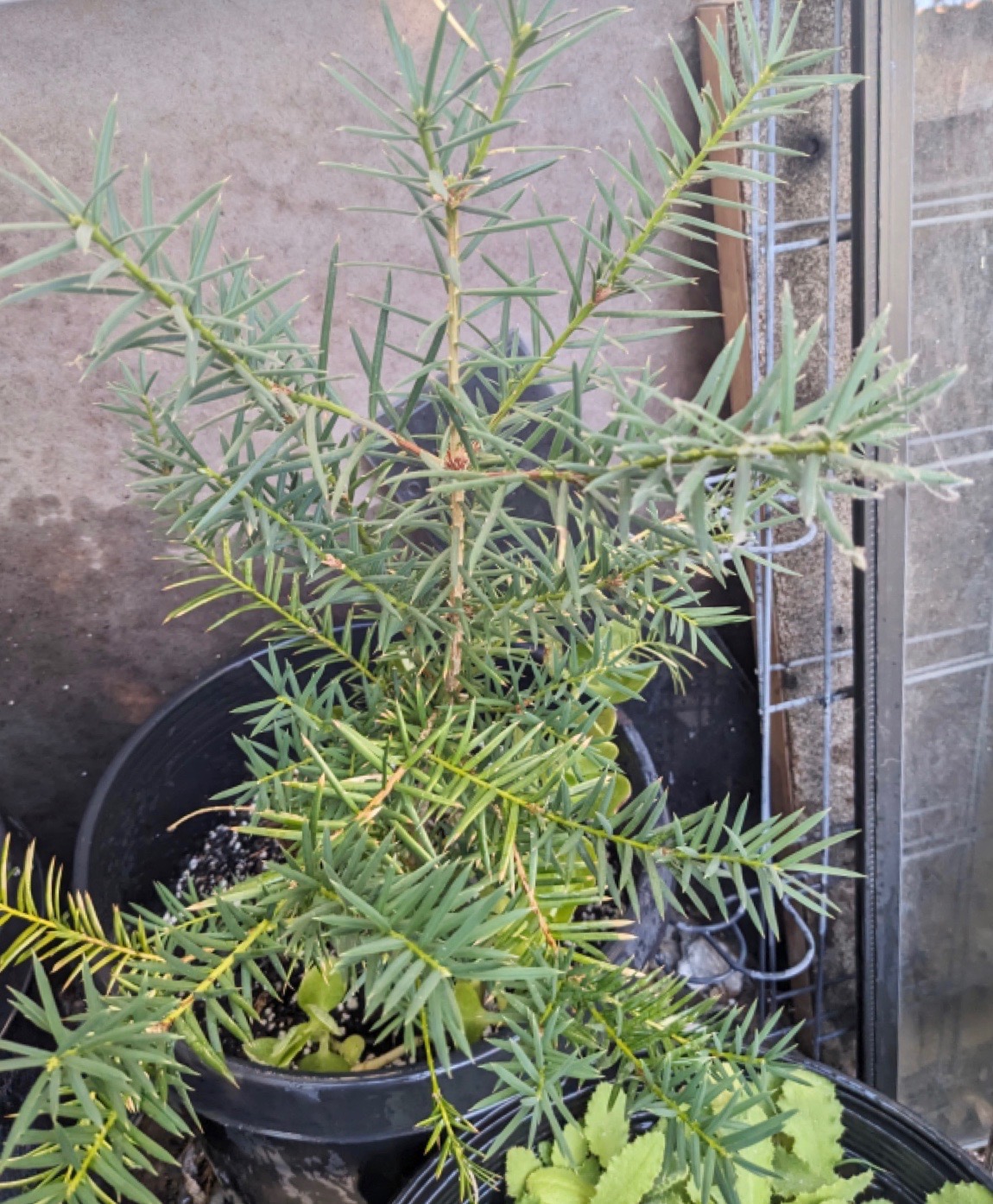 |
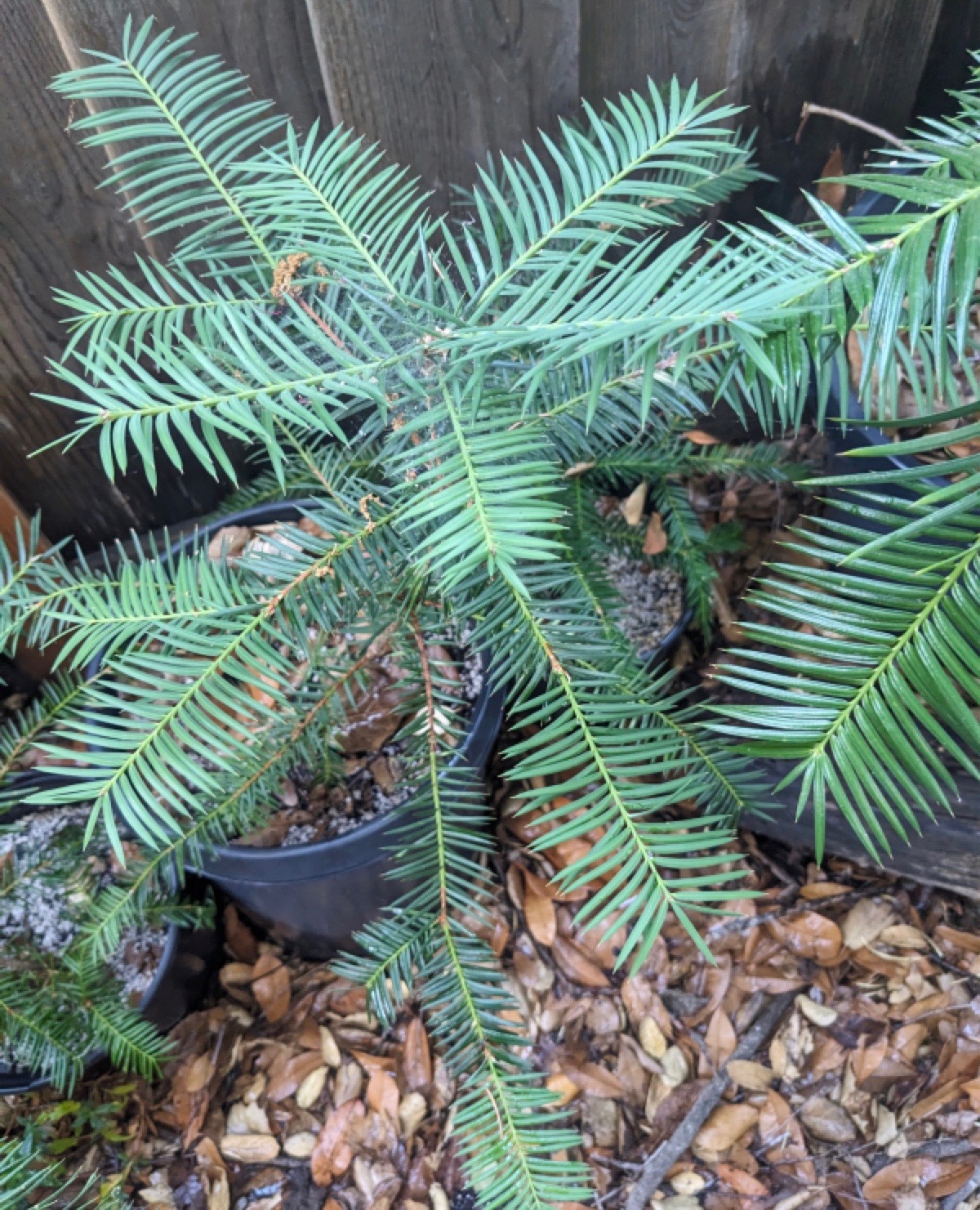 |
|
Although this website began with a focus solely on FLORIDA TORREYA, distinct pages have been added pertaining to CALIFORNIA TORREYA.
Don Thomas is the founder of TorreyaGuardiansWest, for which the main page is here: here. He sent us these two photos of an experiment he is doing at his home in San Jose, California.
The differences are striking in LEAF ADAPTATIONS in full sunlight (and thus also heat) v. the usual flat leaf orientation of subcanopy shade. What is also striking is the color difference. |
• September 2024 / Connie Barlow / INDIANA now has a photo page on our website
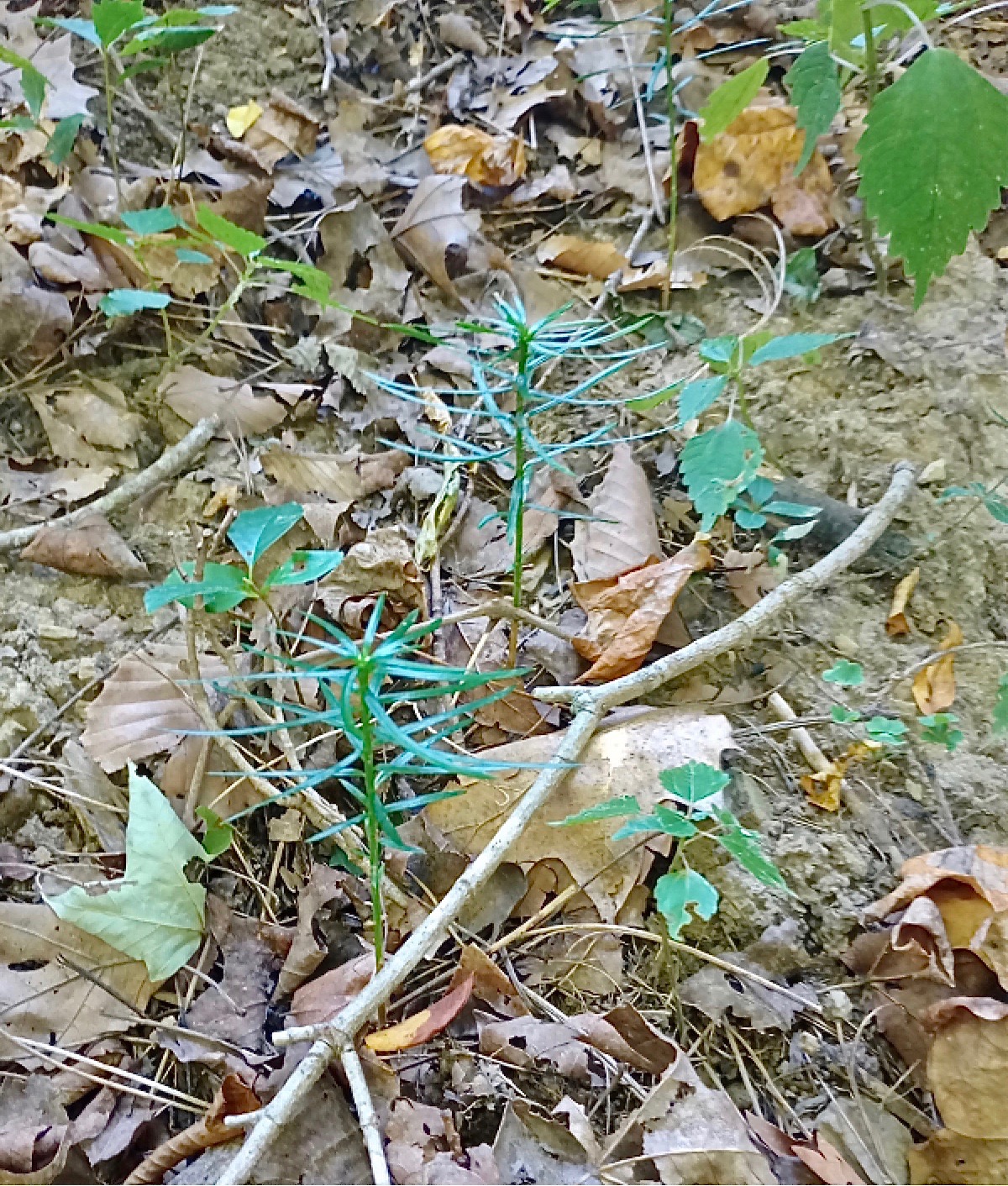 |
|
SITE DESCRIPTION: Forest edge, Indianapolis
TIMING: After 2 winter stratifications (of seeds harvested November 2021 at Clinton and Mt. Olive North Carolina) followed by no germinations, the seeds were assumed to be duds and were tossed into the duff at the owner's forest edge summer of 2023.
Surprise! September 2, 2024 this photo was taken by a volunteer planter near Indianapolis.
Clearly, this is first-year growth of vibrant young seedlings in a sunny location.
This photo is thus another confirmation that it can sometimes take 3 winter stratifications for seeds to germinate.
Note: During the the 2024 growing season, we added 3 new states as page links from the Torreya Guardians homepage: Illinois, Missouri, and Indiana.
|
• August 2024 / Connie Barlow / MISSOURI now has a photo page on our website
This website has state-by-state pages that can be accessed via our homepage. We have distributed seeds to some states in eastern USA that are not listed there, however. This is because, as webmaster, I only create a unique webpage for a state if someone provides a photograph of their torreya planting. However, I just added a photo and text for a MISSOURI page — because:
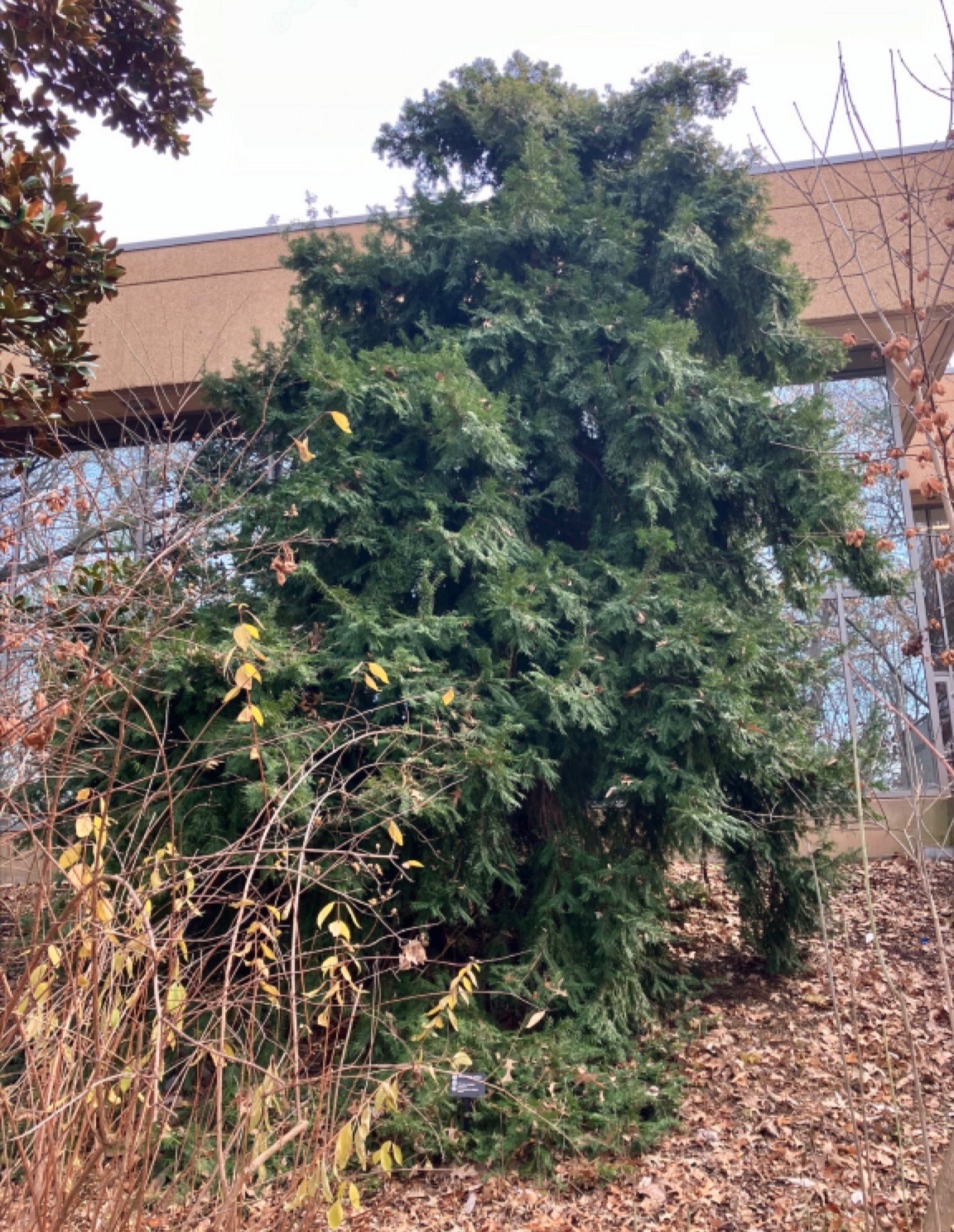 |
|
MISSOURI BOTANICAL GARDEN has online very detailed and complete tabular documentation of all Torreya taxifolia accessions. Data include for each specimen current status (alive or dead), provenance, and garden location.
PHOTO: The earliest acquistion that is STILL ALIVE onsite came from one of the two plants received in 1992 from the Biltmore Estate in NC.
Much later, in 2018, they received from Atlanta Botanical Garden a total of 43 "plants" plus 6 "seedlings." All seedlings (2018-0053) were put into the "Greenhouse outdoors" and are listed as dead. Of the 43 "plants" from ABG in 2018, 26 were put into the "Greenhouse indoors" and all are now listed as "Transferred." Of the remaining 17 plants from ABG listed in various places onsite, 5 are listed as ALIVE.
Of course, the only possible plant at a reproductive age would be the 1992 Biltmore acquisition, as in the PHOTO here. None of the other specimens have photos linked.
Go to our MISSOURI page to access more information about torreya propagation at the Missouri Botanical Garden. Notably, this institution suggests that this species is "probably hardy to Zone 5" — which is significantly north of Florida! |
• August 2024 / Mike Heim and Court Lews / Status reports from Wisconsin and Tennessee
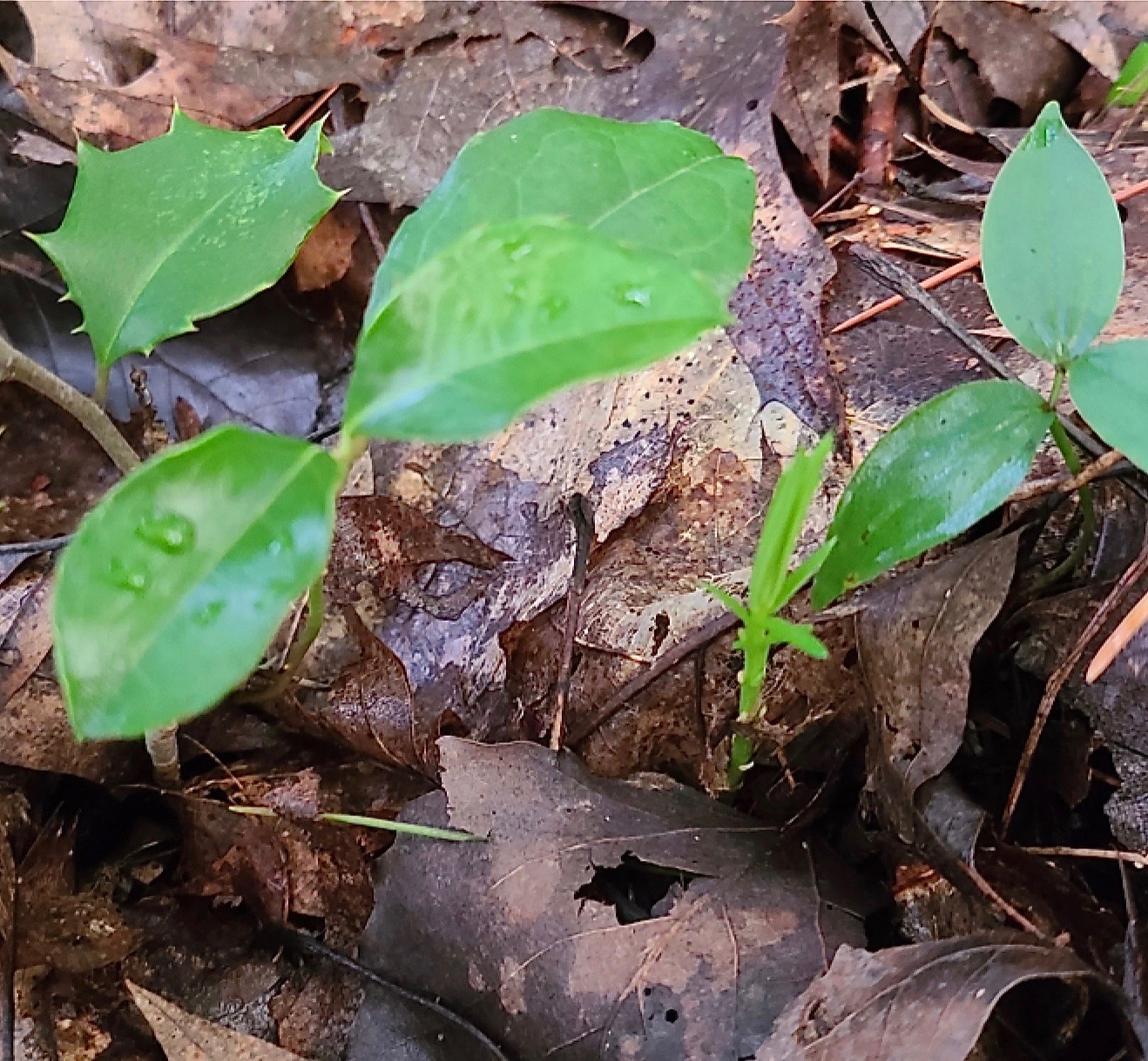 |
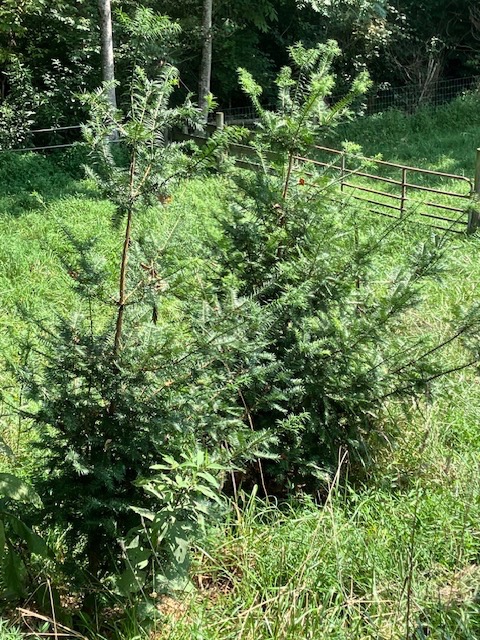 |
|
FAR LEFT: Photo by Mike Heim of Hayward WI, of his third newly emerged seedling this summer.
All three hail from seeds harvested in Clinton and Mt. Olive NC in November 2020 and direct planted in Wisconsin that month, beneath a deciduous canopy and within a fenced deer exclosure.
This photo thus documents that some seeds may take 4 winter stratifications (rather than the usual 2 or 3) before any growth shows above ground.
|
ABOVE MID: Photo taken by Court Lewis of Unicoi TN. 2015 was the final year that superabundant seeds from the ex-situ torreya orchard at Blairsville in northern Georgia were donated to Torreya Guardians. Hence, they are wild genetics, and thus extraordinarily important for eventual seed production. The tallest is 9-feet and the photo shows how full-sun sites (requiring mowing) offer fastest growth.
• August 2024 / Connie Barlow / An Update on TorreyaGuardiansWEST
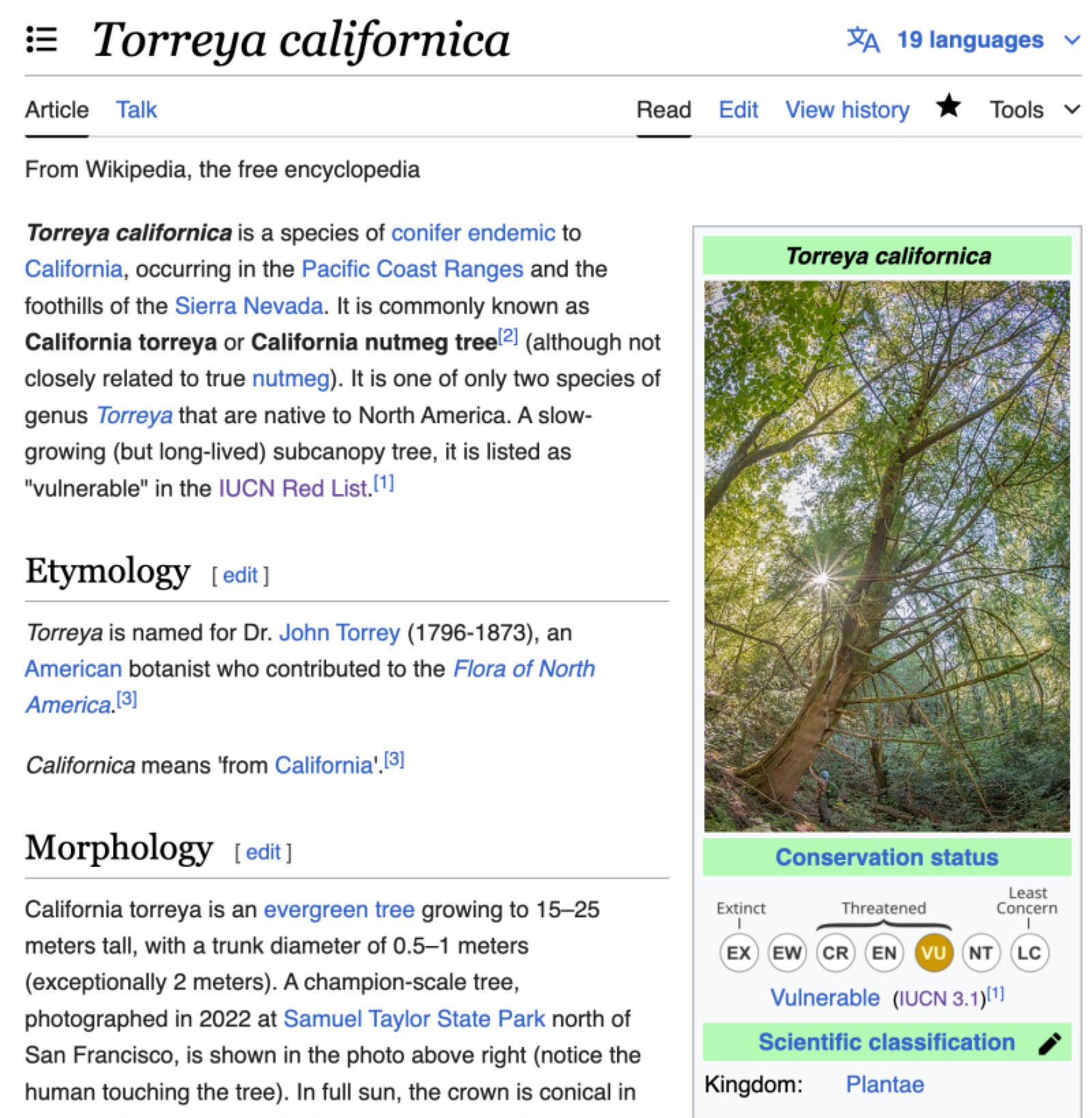 |
|
In 2022, TorreyaGuardiansWEST was founded by Don Thomas. As shown in the WIKIPEDIA screen capture here, California torreya is not a listed endangered species. It is therefore a lot easier for them to obtain wild genetics seeds for their own assisted migration of this endemic California tree northward (as far as British Columbia). Learn more on the California torreya page on this website.
This past week has been a flush of information-sharing emails, focusing on the ablity of the Torreya genus (in California and Asia) to attain great age and size — but always in the mountains and usually on steep slopes.
Torreya is more closely related to COAST REDWOOD than it is to any pine. And in our discussion this month (including one of the lead academics in redwood research in California) we learned of more similarities between the two.
Another of the participants was the person who found and photographed the champion-size Calif torreya that I then inserted into the official wikipedia page of that species.
|
• August 2024 / Jim Thomson and Connie Barlow / Update on torreya planting in Cullowhee, NC
CONNIE WRITES: In preparation for submitting a status report last month to USF&WS on our citizen plantings (see directly below), I queried our planters in order to update those who had sent in enough photos and reports in past years for me to have created site-specific pages of their projects. Sadly, one planter (Nelson Stover in Greensboro NC had died), and one other in NC (older than me!) who had reported a year ago of first seed production has not responded to two of us who tried.
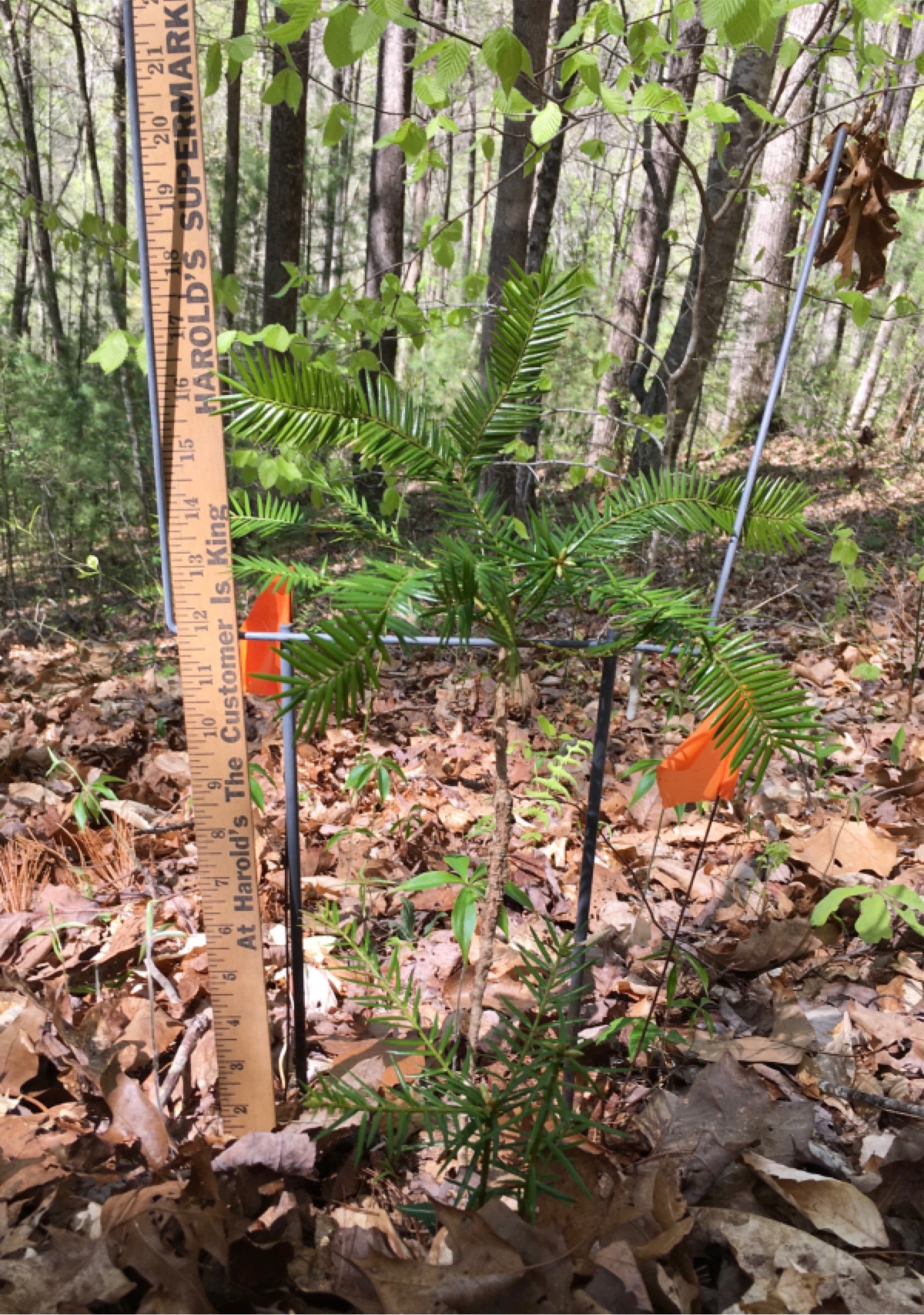 |
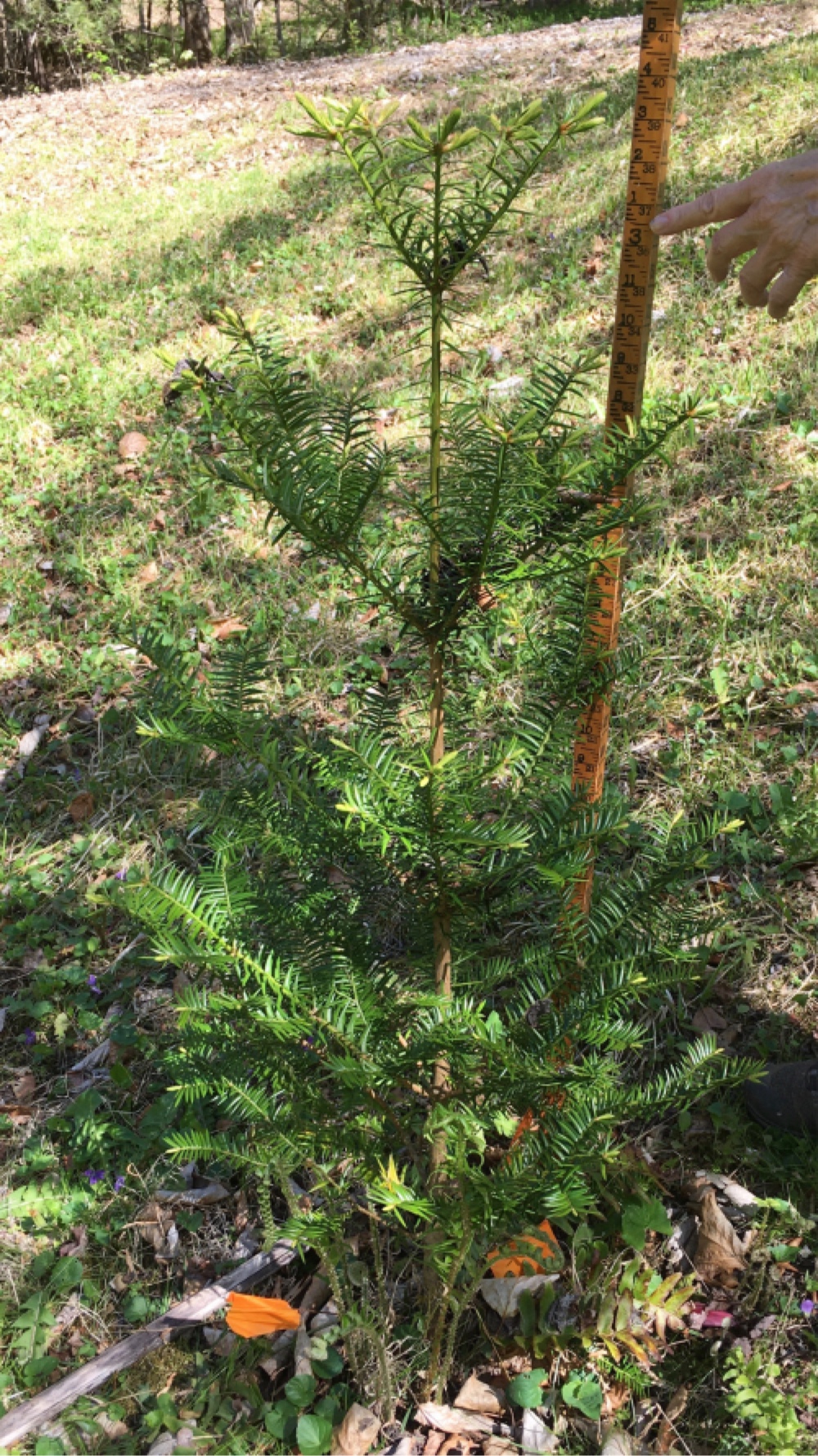 |
|
As a citizen group, our own plantings are almost always limited to private properties — and thus transfers in ownership have been accruing since our first plantings exactly 2 decades ago in North Carolina.
In the case of Jim Thomson who sent updated PHOTOS of his torreyas in Cullowhee NC, the new owners, fortunately, are aware of the plants and will try to preserve them.
These photos (LEFT) reveal typical growth form differences between plantings under a full forest canopy vs. plantings on or next to mowed lawn (which can access more direct sun).
PHOTOS of all 5 torreyas, plus photos and descriptions from previous years, are found on the Cullowhee, NC webpage.
|
• July 2024/ Connie Barlow/ I submitted a 22-page "comment" to provide info and suggested actions for the Florida Torreya recovery plan now being updated
The second and third post below are entries about: (June) announcement that the recovery update begins and (July) a new "3-part framework" that the Fish & Wildlife Service is using this time. ("SSA means "Species Status Assessment"). Comments are being accepted through August 5, but I got mine in early.
Access my full COMMENT in PDF. Below right is my cover letter to the 22-page, highly illustrated, document:
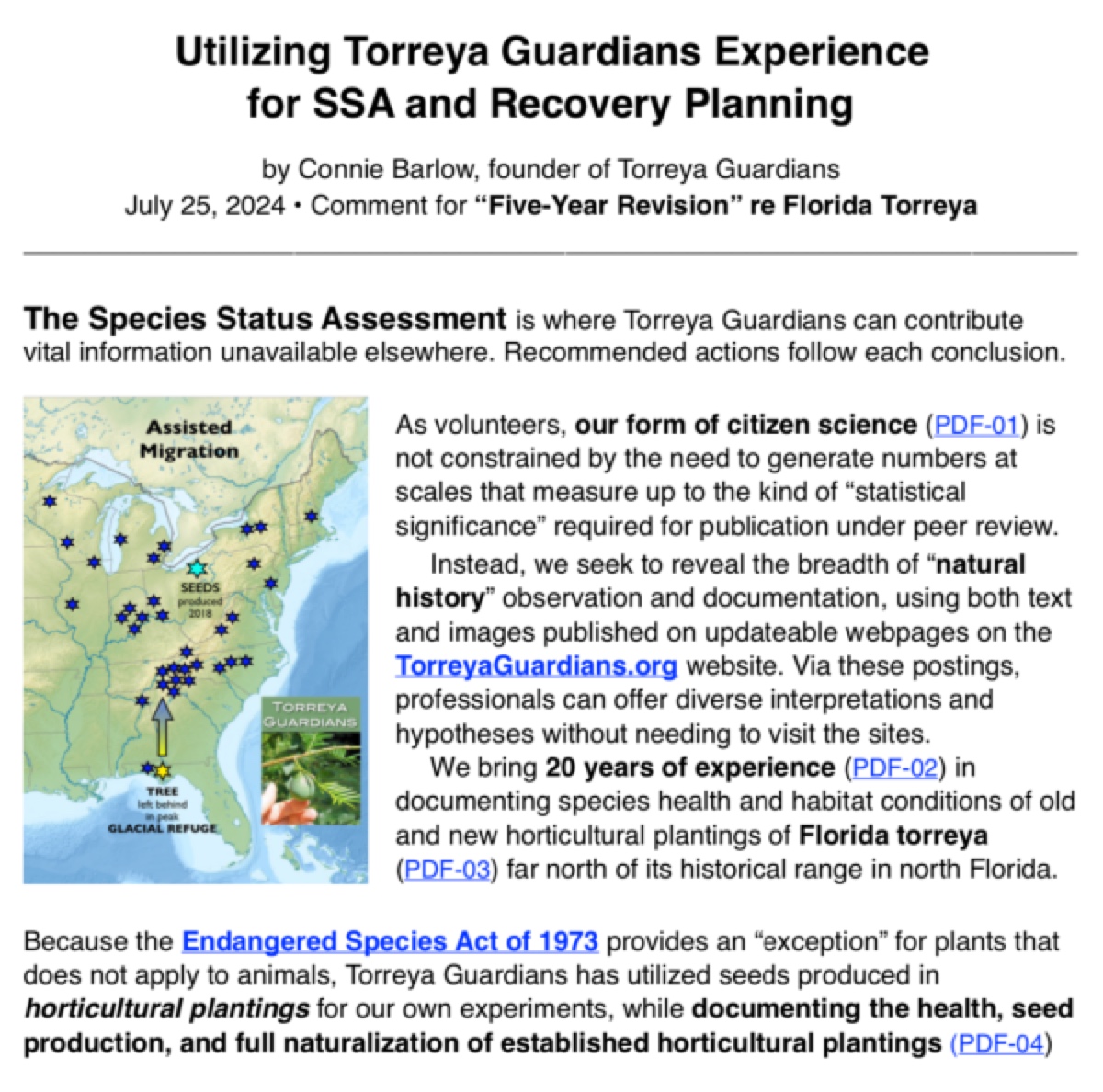 |
|
I, Connie Barlow, founded the citizen group Torreya Guardians in 2005, and I have been its webmaster and chief networker ever since. We have no formal organization, so I write here as an individual. I draw upon two decades of experience in what we have learned about best practices for assisting the northward migration of an ESA listed endangered tree: Florida Torreya. Learn about Torreya taxifolia Natural History on our website.
Torreya Guardians is the first group credited with implementing the long-distance "assisted migration" of a climate-endangered plant.
I am a retired science writer, who specialized in evolutionary ecology (4 books). My bio and publications are on a different website. I am also on Researchgate.
|
Because governmental agencies do not like citations that go to regular web format, I converted 26 webpages on the Torreya Guardians website into PDF format that are all downloadable. Because my comment features the actual experiences of our volunteer planters and those among us who have been documenting the old historical groves in North Carolina, 13 of the total PDFs entail the highly illustrated, site-specific pages of our most successful planters (especially those who send me photos and ongoing results). Additionally, I made and referenced in my document the PDFs made from 2 WIKIPEDIA pages: Torreya taxifolia and Torreya Guardians.
• July 2024/ Connie Barlow and Jake Wells/ First photo documentation of a successful freeplanting of Torreya seeds in Illinois
For the past two years I (Connie) have delayed distributing to volunteer planters the annual fall harvests of Torreya seeds from Cleveland (Parma) OHIO and two homes in central NORTH CAROLINA. Instead, I distribute seeds the following year or even the next. This is because Torreya seeds almost never germinate after a single winter stratifiction. About 3/4 of the viable seeds will germinate after two winters, and the remainder after three. By my stratifying them safely together, this reduces opportunities for rodents to find and dig them up.
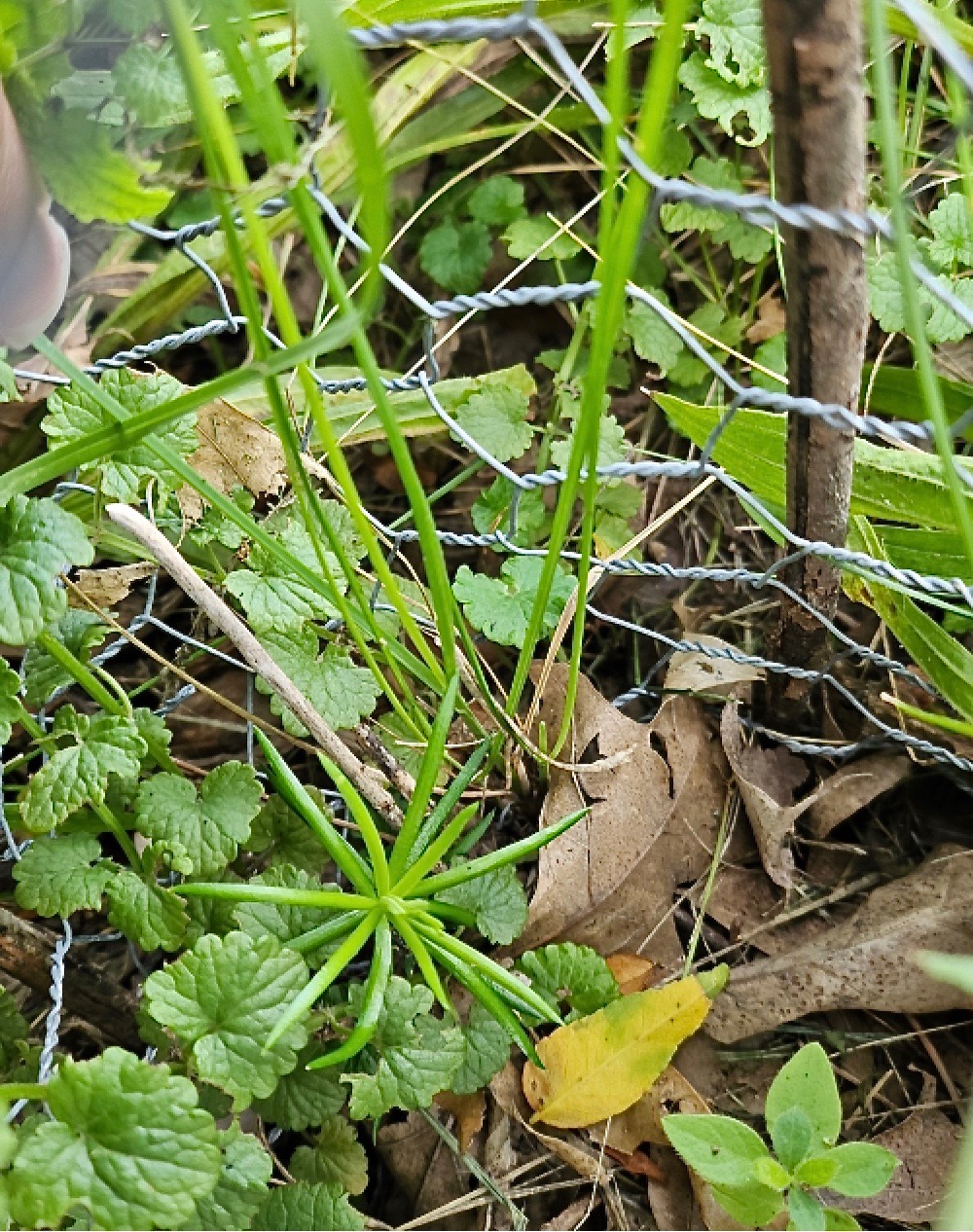 |
|
PHOTO LEFT: This is the first germination of the 40 seeds that Jake Wells planted in late July of 2023. The seeds came from the 2022 fall harvest in Clinton NC (where we were granted permission to collect beginning in 2013).
Jake Wells, who lives near Alpha ILLINOIS, has initiated an experiment. Instead of waiting to see a seedling emerge before caging, he chickenwired each site right after planting the seed. This is very labor intensive!
We already know that caging is crucial to prevent browsing by deer, which can devastate young seedlings. But we do not know how much early herbivory is by rabbits or woodchucks. And even if seeds are planted 4 inches deep, we cannot be sure that squirrels, chipmunks, or tunneling voles won't find them. Chickenwire supported by wooden stakes certainly keeps rabbits, woodchucks, and squirrels away. Jake's experiment will teach us whether early caging is worth the effort.
JAKE wrote, "I am very proud to be part of this grand experiment. The fact that I have been given the chance to help save a species is a privilege. And now that I have a torreya growing, it is even more special. I am so excited to be the first in Illinois to have a documented torreya growing with photos — and to put Illinois on the map!" (Details are on the new Illinois page.) |
• July 2024/ Connie Barlow/ New "3-Part Framework" for recovery planning offers Torreya Guardians collaborative possibilities
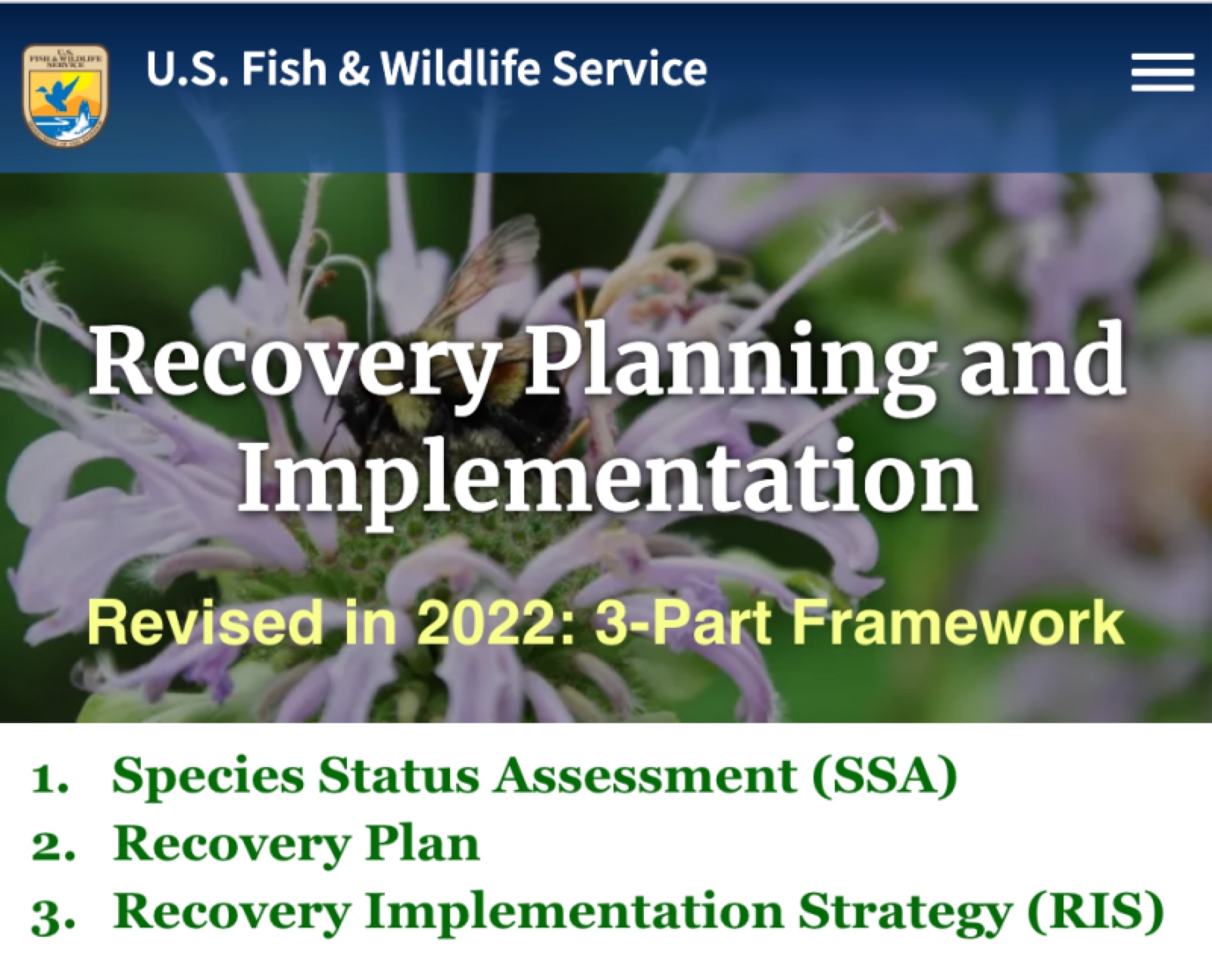 |
|
A google search for how USF&WS recovery planning is done led me to a new webpage. This 3-part framework may finally induce the agency to value what our citizen group accomplishes.
No longer will the two participating botanical gardens in Georgia have the power to veto experimentation in "assisted migration" poleward (which is what happened in 2010). This is because "working groups" are a thing of the past.
Instead, comments received from everyone during the update process will be considered by agency staff in writing just the basic statutory elements required in a "recovery plan." These include targets for rises in population numbers that will constitute success for downlisting and delisting. Also included will be categories of actions for moving toward success.
But a lot of elements that are in the official plans now will be shifted into two flexible and updatable documents. This is where our group can shine. They are:
|
• The SPECIES STATUS REPORT (SSA) for Florida torreya: Here we can offer agency staff documentation of (a) the geographic inventory we completed of Historic Groves of old horticultural plantings, (b) results of our own volunteer torreya plantings (including seed production in Ohio) and (c) our ever-growing sense of best practices for propagating, siting, and nurturing this species in a variety of states and habitats northward of this glacial relict's tiny historical range.
• RECOVERY IMPLEMENTATION STRATEGIES (RIS)
will for the first time be authorized for the agency to develop separately with each participating institution. Thus the agency could explore a separate RIS to be carried out by our group. So long as experimentation in assisted migration is included as an action category in the official recovery plan update, the agency will be free to explore this option. Our willingness to engage in supportive actions for Florida torreya without needing any funding is likely to make us very attractive as an RIS collaborator.
• June 2024/ Connie Barlow/ Florida Torreya Recovery Plan Update begins — Opportunity for Torreya Guardians to comment
We've got until AUGUST 5 to post comments. I alerted the main group of planting volunteers right away. Meanwhile I am trying to have a phone conversation with a relevant staffer to accomplish two things:
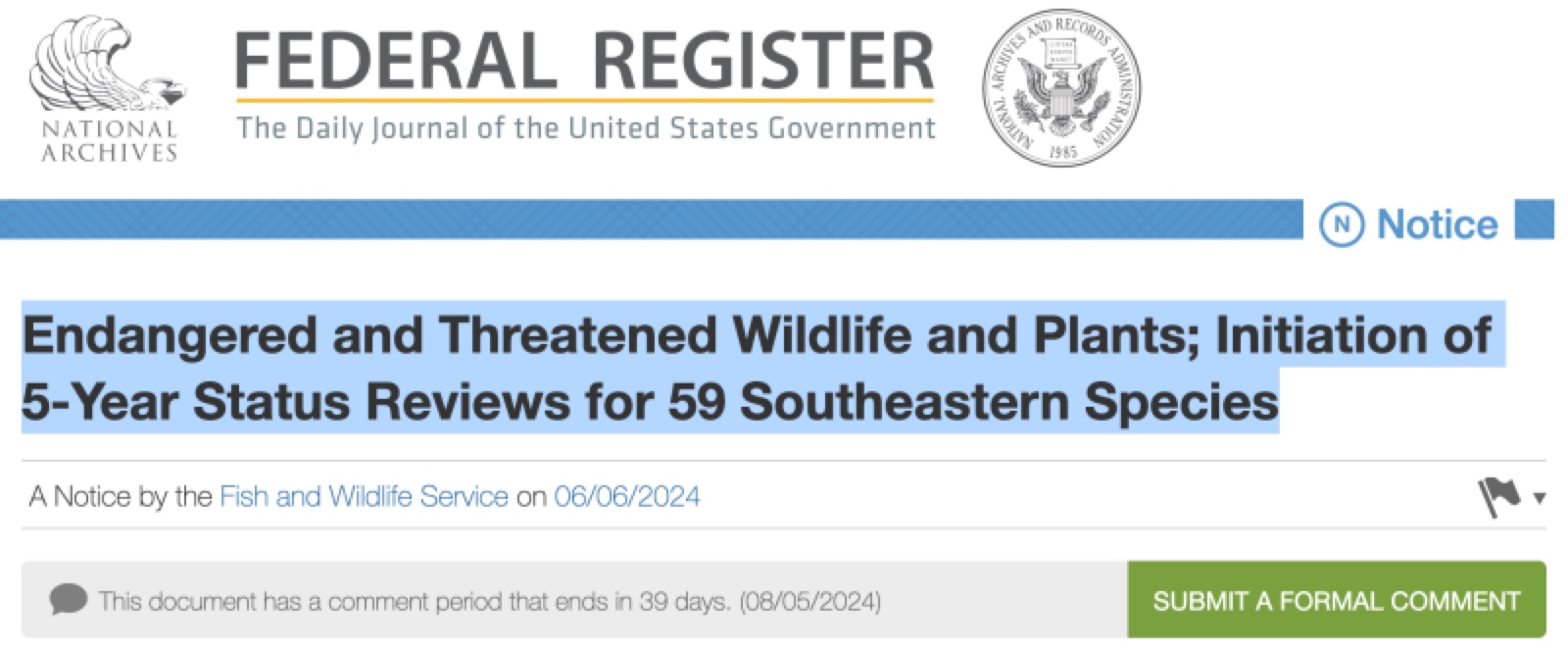 |
|
(1) Gain assurance that several of us will be invited to partipate officially in the Working Group for Florida Torreya. We are stakeholders no less than the park managers, private landowners, and botanical gardens who are attempting to help this species in its "historical range" in Florida and Geogia.
(2) How might our collaboration be most helpful? What specific information and discoveries we have made might be most useful to include in our comments?
|
• June 2024/ Connie Barlow/ "Latent pathogen" discoveries could help Torreya Guardians advocacy
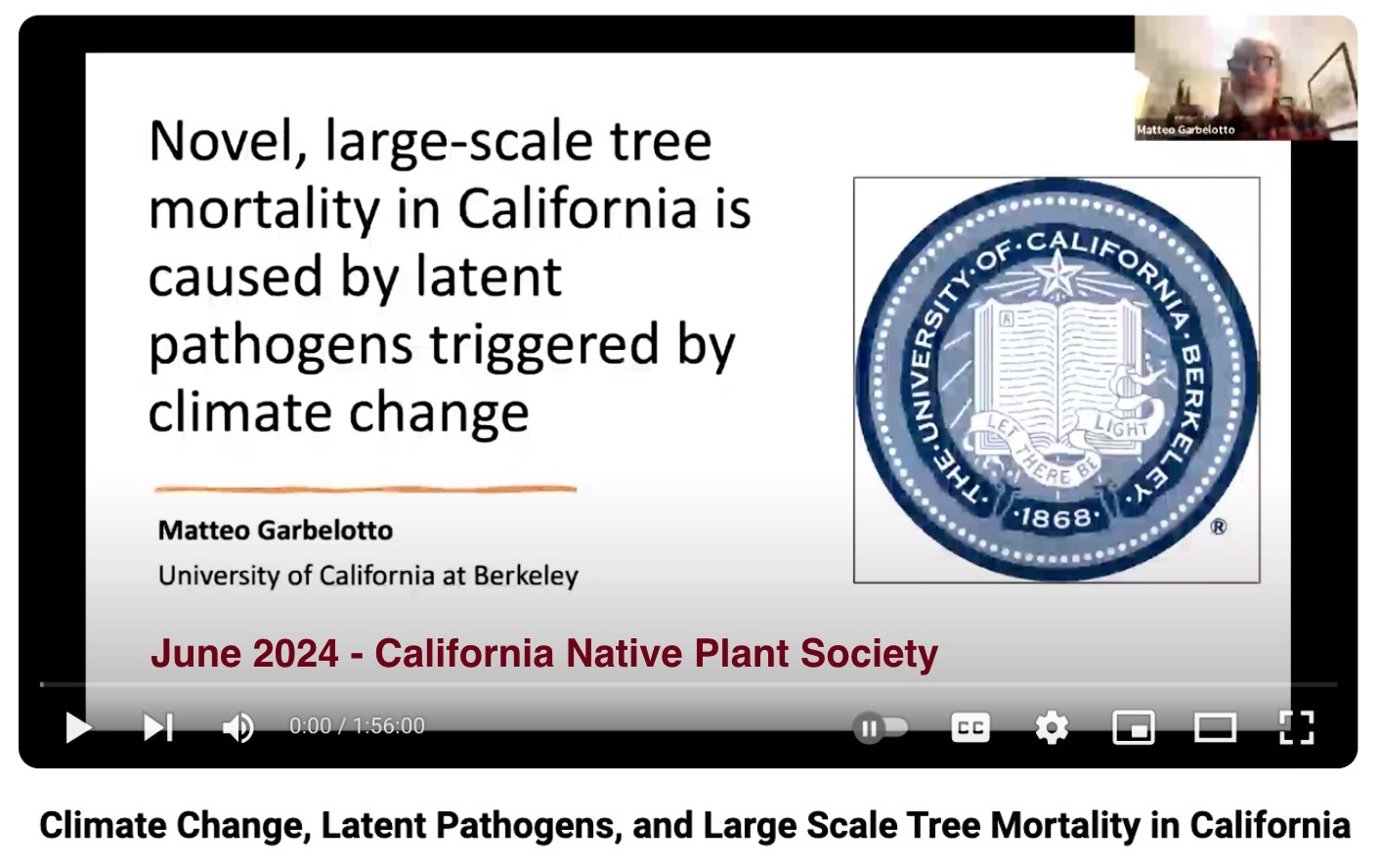 |
|
At timecode 01:46:04, a 2-minute section of a long forestry video is where MY QUESTION is read to the guest speaker: "Do you recommend assisted migration, northward, upslope, or onto north-facing slopes?" His response was generally positive. "I don't see anything wrong with it. It's happening already.... In the Sierra Nevada, trees are moving upslope."
As the lead forest pathologist in the state, Prof. Matteo Garbelotto had talked about the scale and causes of the shockingly unexpected and sudden tree deaths happening in the San Francisco Bay area — all unquestionably attributed to the recent extremes of heat and drought. These, in turn, empowered native fungi to kill previously healthy trees.
|
HOW CALIFORNIA'S EXPERIENCE COULD HELP FLORIDA TORREYA: Torreya Guardians have long been conducting our own "assisted migration" experiments northward by using seeds produced from horticultural plantings in the Appalachians and northward. However, the two botanical gardens who control the ex situ wild-stock plantings in northern Georgia have stalled in collecting and distributing the prolific annual seed production — out of fear that the newly named Fusarium torreyae (which is present in all tissues, including seeds) might be able to harm other native trees. In his talk, Prof. Matteo Garbelotto (U.C. Berkeley) used the term "latent pathogens". These are native fungal and bacterial "endophytes" that are always present within tree tissues, "possibly beneficial", but then turn lethal when their host trees become climate stressed.
In contrast, when the globally known fungal disease Fusarium lateritium that has long been identified with root necrosis and/or stem cankers in Florida Torreya was renamed in 2013 as a new species, Fusarium torreyae, the fear arose that it might not be a native disease (triggered by Holocene warming to kill a left-behind glacial relict). Rather, it might be from another continent, introduced by the horticultural trade mid-20th century, as that is when the massive deaths of torreya trees began. Now consider: "Latent pathogen" is another name for a commensal or mutualistic microbial member of the "plant microbiome" that turns deadly when its host is stressed. This is especially true of the subset of fungal mutualists that normally pass their own descendants forward as part of the SEED MICROBIOME. Scroll down to this entry to learn more about the possibility that Fusarium torreyae may actually be mutualistic with Florida torreya in northward climates: • December 2023/ Connie Barlow/ Botany papers reveal that Fusarium torreyae is actually a mutualist, only becoming pathogenic when the host plant is stressed.
• May 2024 / Buford Pruitt/ Squirrels can be helpful — if one has hundreds of seeds
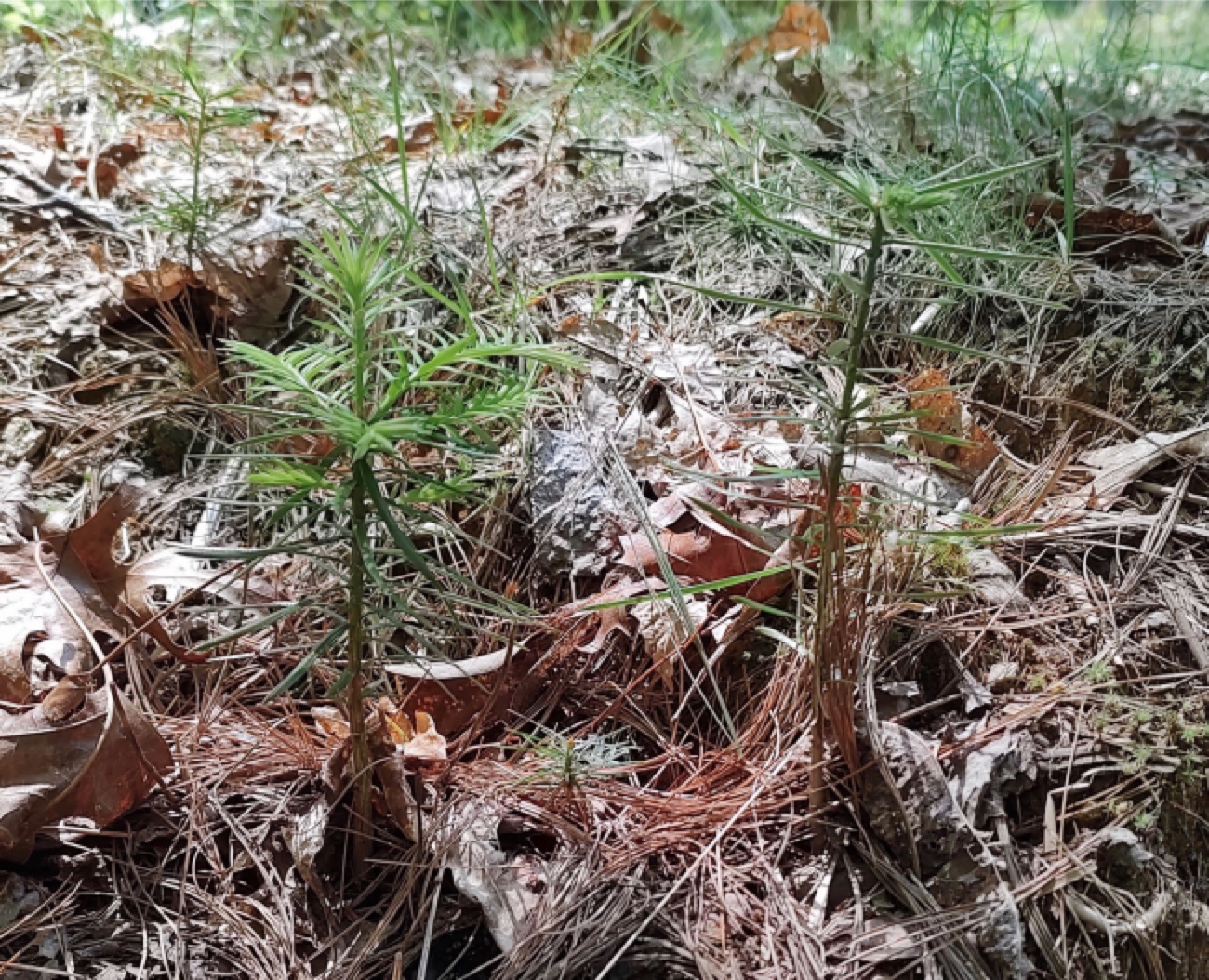 |
|
May 28 email from Buford Pruitt in Brevard NC:
"... Fred Bess had also sent me seeds to be scattered in natural habitat, some of which I put 4 to 6 inches deep into the ground and others I merely placed within the leaf litter.
Two of those seeds germinated this year and are currently 6+ inches tall (see photo).
They came up at the edge of my picnic table area — way too close to the table for me to have placed them there. Their needle-tipped leaves are not needed at picnics!
So, I believe squirrels found them in the leaf litter and planted them. I plan to relocate them."
Note: A year ago Buford contributed a 3-page analysis of the range of ways in which squirrels provide seed dispersal services in the wild.
|
SEE ALSO:
See the DECEMBER 2019 entry by Clint Bancroft on his torreya page: evidence that a squirrel carried and planted a seed some 200 feet distant from the seed pot it had worked its way into!
QUESTION: Has anyone tried putting CHILE FLAKES just below the soil surface when covering up a deep-planted seed?
• May 2024 / Russell Regnery and Connie Barlow / Unlike Florida Torreya project, Wollemia tree project encourages citizen plantings
CONNIE writes: Russ Regnery (Torreya Guardian NC) alerted me to this 2022 paper, "Home gardens contribute to conservation of the critically endangered Wollemi Pine: Evaluation of a botanic garden-led horticultural release programme", by Catherine Offord and Heidi Zimmer,
published in Plants, People, Planet.
In the late 2010s a new charge was launched against us: that we might inadvertently be spreading northward an allegedly exotic fungal disease by moving torreya plants (and even just their seeds) north. Even though professional botanists are now recognizing that fungal species routinely found within the seeds of a host plant are a strong sign of mutualism (becoming pathogenic only when the host is too stressed to produce seeds), the botanical gardens are still letting their ex situ seed production in northern Georgia go to waste. Accordingly, they criticized our group for continuing our own distribution of horticulturally grown seeds and thus our northward planting projects. At least one professional is still speaking of Fusarium torreyae as an exotic fungal disease and as a danger to other tree species in the eastern USA — even though the scientific papers did not document an exotic source. As well, there are no peer-reviewed published papers documenting dangers to other tree species. Inoculations of potted plants of other species by a graduate student in laboratory settings in Florida cannot determine susceptibility of those same tree species when supported by climate and mutualists of their own natural ecological settings in the Appalachian Mountains.
• April 2024 / Connie Barlow / Superb forest slope of new torreya planter in Illinois
After 1 winter stratification here in the ground in Michigan, I sent seeds from Fred Bess's 2023 harvest (Cleveland, Ohio) to 5 new torreya planters, including our first planter ever in NEW JERSEY. Photos above are where our new planter in Peoria ILLINOIS will be putting his torreya, following germination and growth into seedlings after maintaining the seeds safely for a second winter stratification. The steepness of the slope, with lots of Christmas ferns under a deciduous canopy, look like ideal habitat. Caging against deer browsing will be put in place if necessary.
• March 2024 / Mike Heim and Connie Barlow / Torreya survives a crazy winter in northern-most planting
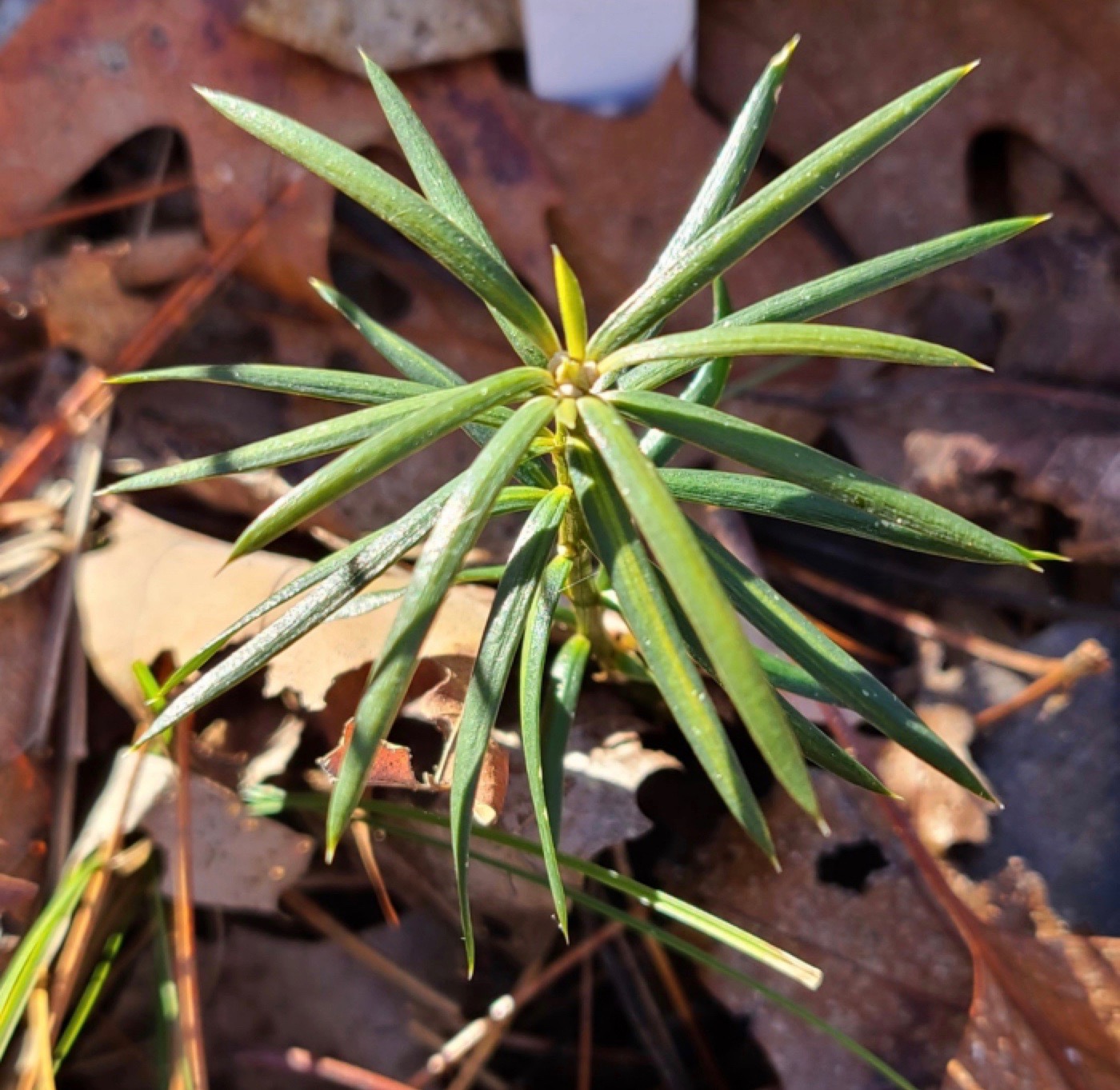 |
 |
|
Back in February, Mike Heim contributed photos of 5 of his torreya seedlings during a winter of relatively little snow in Wisconsin. A springlike week in February is the photo left. Snow arrived again in March (right).
Mike reported that the coldest temperature this winter was -16F (not bad for northern Wisconsin!). Fortunately, the seedlings were covered in snow then. He reported "-6F is the coldest they've been exposed to."
You'll see lots more photos on Mike's Wisconsin Torreya page.
|
Now, compare the Wisconsin Torreya to a Torreya Guardians planting in the panhandle of Florida below. That's quite a climate span for a species to cope with! Such experiments are extremely useful in this time of rapid climate change.
• March 2024 / Chris Larson / Photo of seedling at Shoal Sanctuary in the Florida panhandle
 |
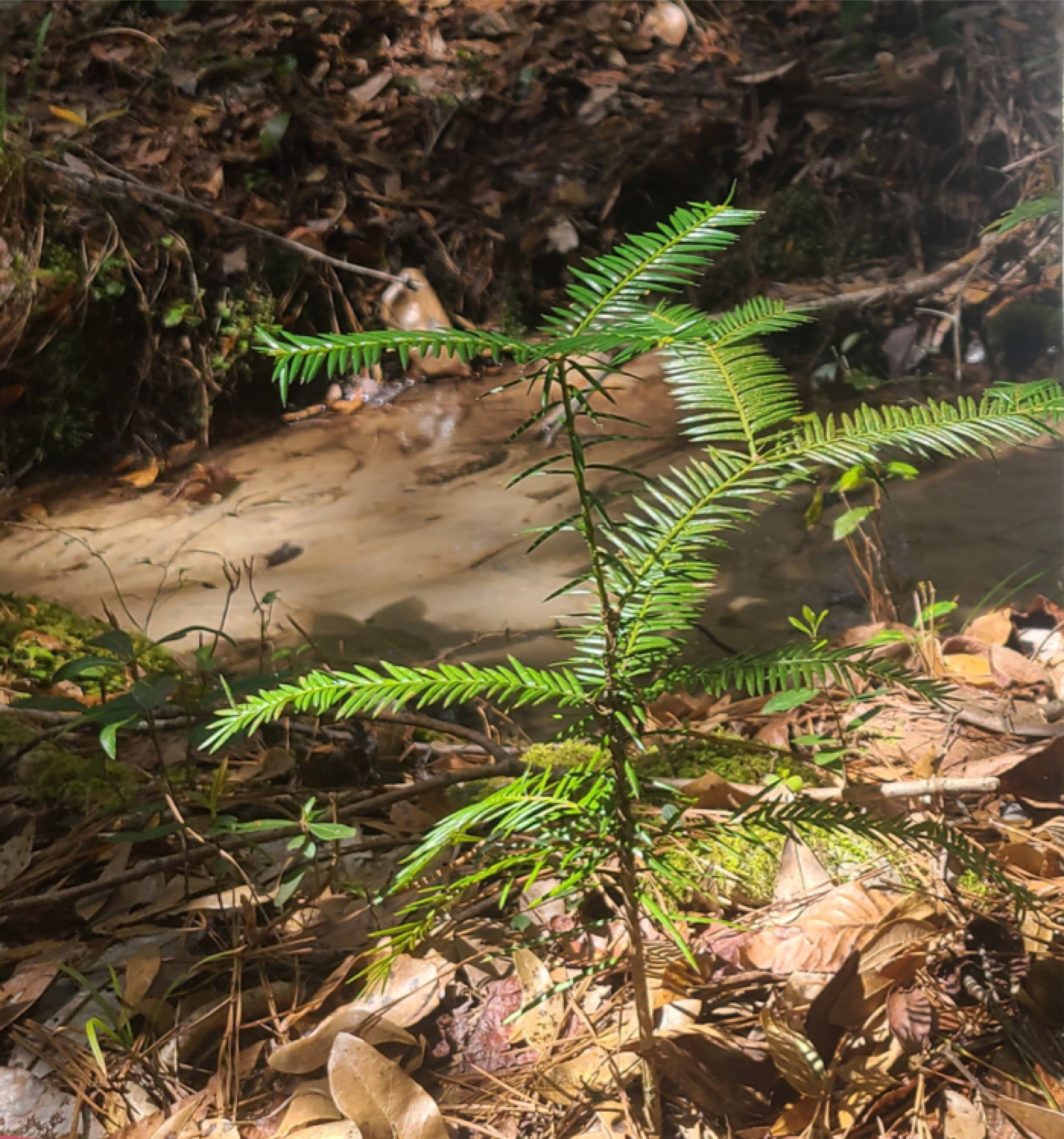 |
|
MARCH 20, 2024: Chris Larson sent this photo of one of the remaining Florida Torreya seedlings, 9 years after the seeds were "freeplanted" directly into the forest.
Notice the creek in the background.
The topographically rich and forested land in this region of northern Florida contains the same kinds of "steephead ravines", with small creeks at their bottoms, that provides crucial habitat in the original relictual range eastward in the panhandle. |
IMPORTANT: Notice the absence of deer herbivory on this perfect seedling. (The seedlings have never been "caged".) Hunting is a normal activity in this very rural part of Florida — in contrast to prohibition of hunting in Torreya State Park, where herbivory has been severe.
• March 2024 / Connie Barlow / Estella Leopold dies at age 97 (she told Torreya Guardians about a Miocene Torreya fossil in Washington state)
New York Times posted an obituary of Estella Leopold (last surviving offspring of Aldo Leopold) on March 5. She was 97. I was scheduled to meet her in Seattle in 2017, while I was volunteering there for the "Valve Turners", but she had to go to the hospital for a lung condition, so that never happened. Earlier she and I had engaged in e-correspondence about Torreya taxifolia and her team's finding a Miocene torreya fossil in Washington state. I am grateful that I kept and posted the Leopold-and-Barlow correspondence.
• March 2024 / Connie Barlow / Three Torreya Guardians report germination after 3 winters
(1) End of February 2024, Mike Heim of Hayward WI sent me photos of the 5 torreya seedlings that had emerged Summer of 2023 from NC seeds that Mike had planted directly into his deer exclosure right after the Fall harvest, November 2020. Thus, it took 3 winters in the ground before those seeds produced seedlings.
(2) Early March 2024, Connie Barlow in Ypsilanti MI decided to check on how the NC seeds from the 2021 harvest were doing, after spending a third winter stratifying. She was shocked and delighted that of the 45 seeds that had not germinated (as many do) after their second winter stratification 34 had already germinated by early March after their third winter. Indeed, the roots had already lengthened so much (see photo left above) that they could easily break during shipment or even during careful planting here in Michigan. Statistics: 45 total seeds, of which 34 had germinated, 4 were dark gray (no longer healthy brown) and upon dissection were confirmed dead, 1 had a white wormy insect larva emerging from its round depression near the tip, 2 had the triple crack that precedes germination, and the remaining 4 had the customary thin slit at the tip that precedes the triple crack. The experiment now continues with the remaining 6 healthy brown seeds.
(3) Mid December 2023, Paul Camire of Capac MI was surprised that he still had a neglected bag of November 2021 harvested NC seeds in his refrigerator. So he pulled out the bag and put it in his basement. Connie's early March report that her third-winter stratified seeds had already germinated prompted Paul to check his bag of 2021 seeds. He found that two had just started to germinate (photo above right).
• December 2023/ Connie Barlow/ Botany papers reveal that Fusarium torreyae is actually a mutualist, only becoming pathogenic when the host plant is stressed.
Using Google Scholar, and also aided by the PLANT MICROBIOME page on wikipedia, I encountered a raft of recent botany papers concluding that fungal propagules regularly found in seeds entail the SEED MICROBIOME. Even beneficial fungal partners, however, may express pathogenically if a plant host becomes too stressed to produce seeds.
IMPLICATIONS AND QUESTIONS: Might this explain why Fusarium torreyae had first been detected in stem cankers within the historical range, yet subsequent observations had also detected it in all seeds produced in northern Georgia? Might the professionals in charge of torreya seed policy not be aware of these recent papers — which entail a marked paradigm shift? As well, is there some way that Torreya Guardians could ensure that these papers would be considered in the next 5-year plan update, due in 2025?
Toward fostering professional and public awareness of technical papers that brought about this paradigm shift, I posted a lengthy new webpage that links and excerpts the main papers. I use a chronological framework that also lists and excerpts previous scholarship (beginning in 1967) exploring possible causes for the demise of Florida torreya within its historical range. I also produced a video introduction to the paradigm shift and the history of scholarship pertaining to Florida torreya:
• Published Documents on Endangerment Causes of Torreya taxifolia in Florida
(Table of contents for this lengthy new webpage is below.)
• VIDEO on the paradigm shift
(Title: "Assisted Migration of Climate-Endangered Plants - Torreya Guardians lead the way")
 |
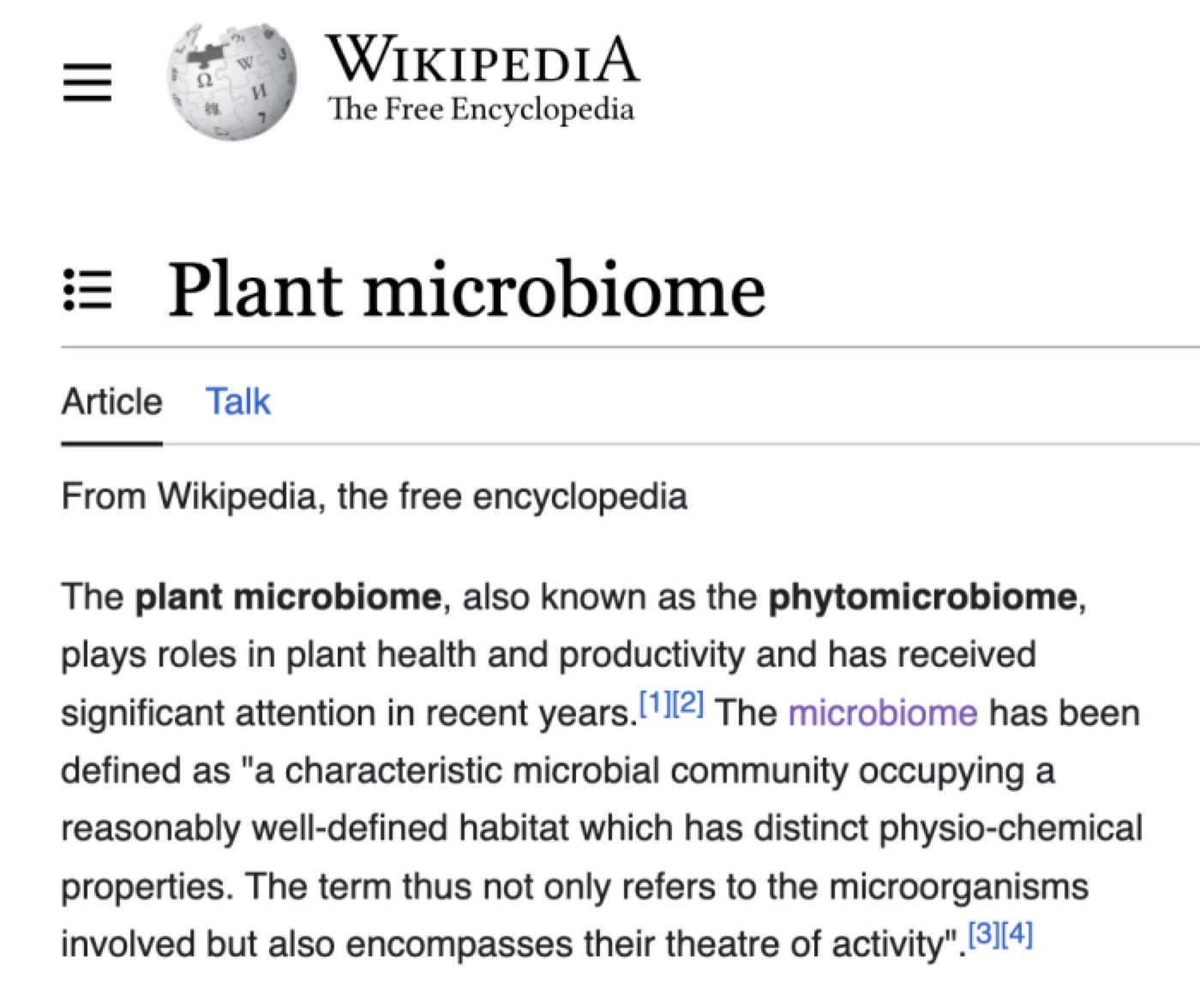 |
• December 2023 / Daein Ballard / NEW HAMPSHIRE discoveries on full-sun torreyas
SUMMARY (by Barlow) of the New Hampshire report: Three of the 6 photos Daein Ballard sent us in December are shown above. Significant findings include (1) At least in full-sun sites, torreyas as far north as southern New Hampsire will have 2 growth spurts annually — just like we have documented in full-sun Tennessee. (2) The full-sun torreya growth form is less yew-like than in shady habitat (see the lower portion of the middle photo above). Daein reports that the full-sun leaf pattern deters deer. This is likely because the deer cannot avoid getting poked by the very sharp needle tips when it tries to bite off the end of a lateral. See how the full-sun growth form is very similar to that already demonstrated by Fred Bess in Ohio. (Go to the Cleveland-Ohio page and scroll down to the October 2018 photos.)
• November 2023/ Connie Barlow/ New VIDEO reviews history of search for Torreya's causes of endangerment — and implications of the new papers on PLANT and SEED MICROBIOMES